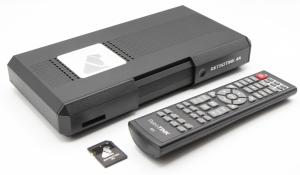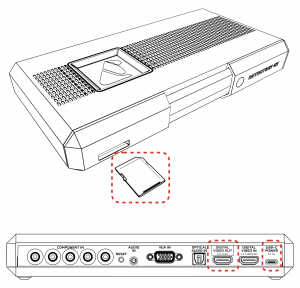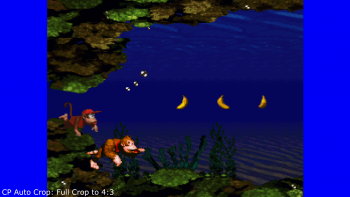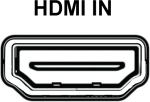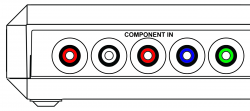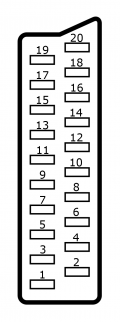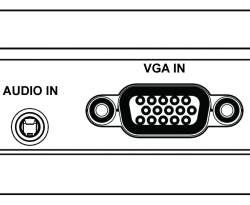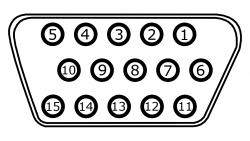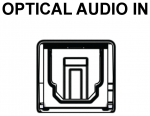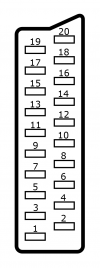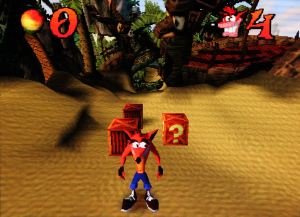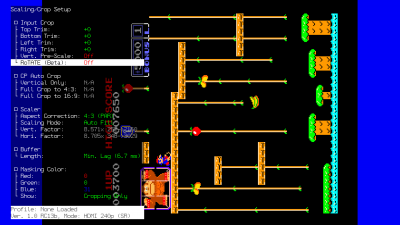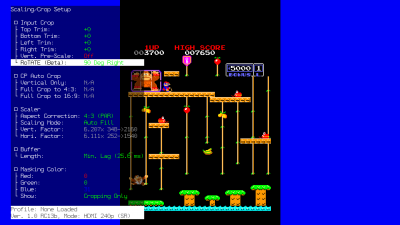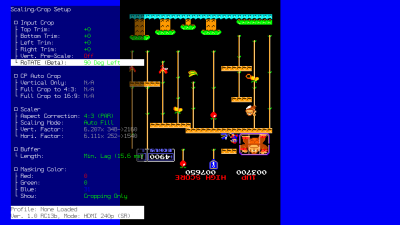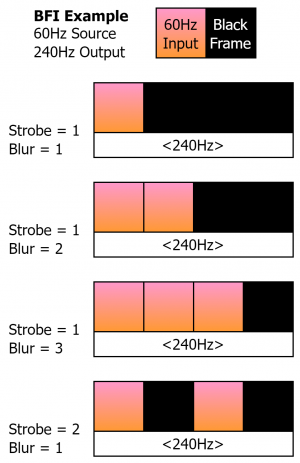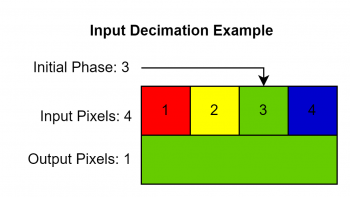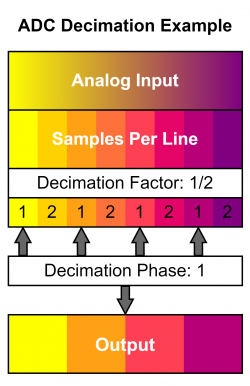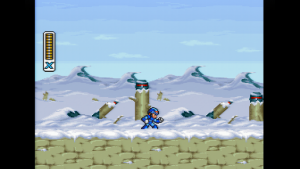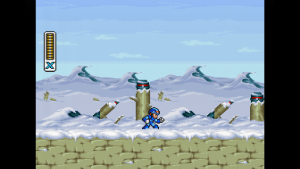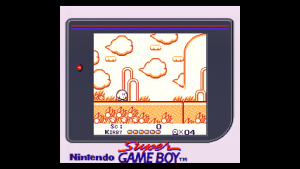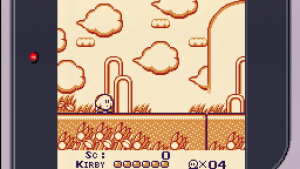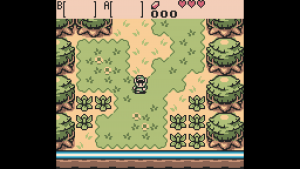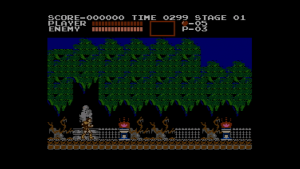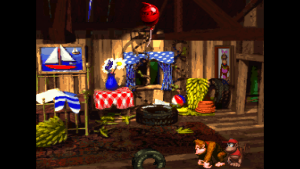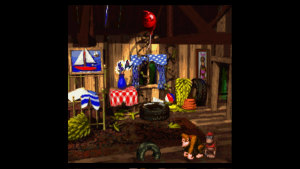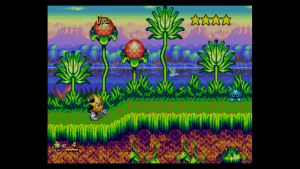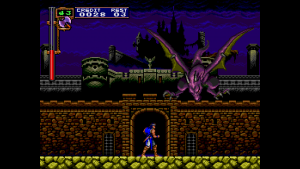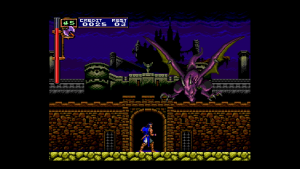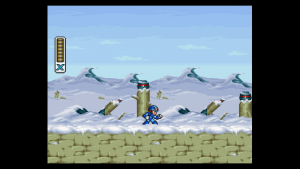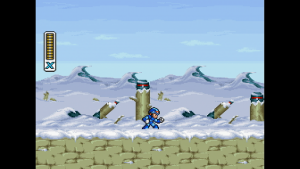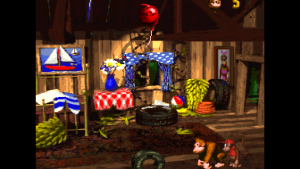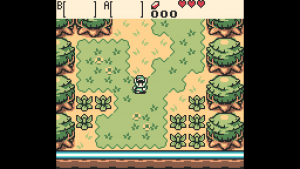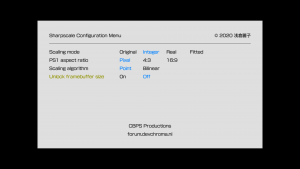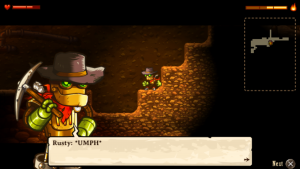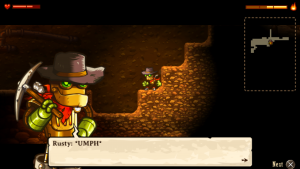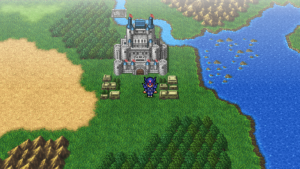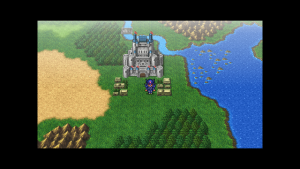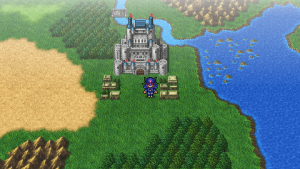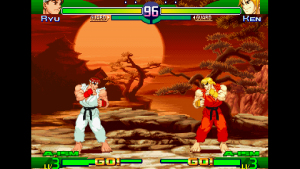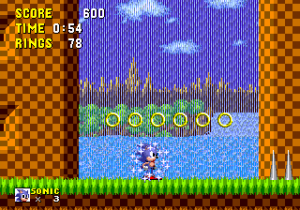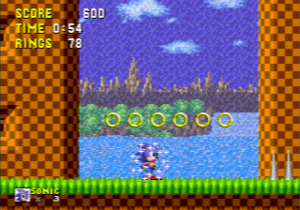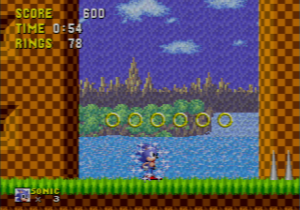AV:RetroTINK-4K: Difference between revisions
(Limit TOC to depth of 3 (sort of 2 since page counts as a level)) |
|||
| Line 1,561: | Line 1,561: | ||
| colspan="2" | -29 | | colspan="2" | -29 | ||
|} | |} | ||
The majority of Super NES / Famicom games run in 256x224 resolution, while a select few games run with a mix of the following: 512x224 in the whole screen for menus, 256x224 for most of the image while running 512x224 over certain parts of the screen to create transparency effects, or the same but using 512x224 resolution to allow sharper text on the screen. It is recommended to run the Super NES in 512x224p mode to make sure you get all available detail. (https://consolemods.org/wiki/AV:RetroTINK-5X_Pro#512_%22Hi_Res%22_Games) | The majority of Super NES / Famicom games run in 256x224 resolution, while a select few games run with a mix of the following: 512x224 in the whole screen for menus, 256x224 for most of the image while running 512x224 over certain parts of the screen to create transparency effects, or the same but using 512x224 resolution to allow sharper text on the screen. It is recommended to run the Super NES in 512x224p mode to make sure you get all available detail. | ||
[pending screenshots of Trials of Mana or Kirby game with 512 mode vs 256 mode] | |||
This topic is a WIP, please see the same topic on the RT5X wiki | |||
(https://consolemods.org/wiki/AV:RetroTINK-5X_Pro#512_%22Hi_Res%22_Games) | |||
We recommend using a Super NES model number SNS-001, or Super Famicom model number SHVC-001, and an RGB SCART cable wired for Sync-on-Luma, as this works with both of the aforementioned models. There are internal revisions of these models, noted as "1-Chip" on the motherboard, and the 1-Chip-03 does not work with Composite Sync. There is a revised model, SNS-101 and SHVC-101, also known as the Super Nintendo Junior. This model only supports composite video. | We recommend using a Super NES model number SNS-001, or Super Famicom model number SHVC-001, and an RGB SCART cable wired for Sync-on-Luma, as this works with both of the aforementioned models. There are internal revisions of these models, noted as "1-Chip" on the motherboard, and the 1-Chip-03 does not work with Composite Sync. There is a revised model, SNS-101 and SHVC-101, also known as the Super Nintendo Junior. This model only supports composite video. | ||
| Line 1,610: | Line 1,616: | ||
* For correct Super Game Boy pixels, go to Advanced Settings > Scaling/Cropping, then set Aspect Correction to "1:1 (Sq. Pixel)". | * For correct Super Game Boy pixels, go to Advanced Settings > Scaling/Cropping, then set Aspect Correction to "1:1 (Sq. Pixel)". | ||
Profile included to maximize the Game Boy window to the screen, or 15x the original GB pixel count. | |||
Profile included to maximize the Game Boy window to the screen. | |||
=== Nintendo 64 === | === Nintendo 64 === | ||
| Line 1,740: | Line 1,745: | ||
|[[File:DKC Wii 480p no Fix.png|center|thumb]] | |[[File:DKC Wii 480p no Fix.png|center|thumb]] | ||
|- | |- | ||
|Genesis | |[Pending Picture of Ristar on Genesis 10x DAR] | ||
|Wii VC | |[[File:RS Wii VC Default settings.png|center|thumb]] | ||
|- | |- | ||
|TG16 | |[[File:CVRoB TG16 Optimized 10x.png|center|thumb|NEC Turbo Grafx 16]] | ||
|[[File:CVRoB Wii Framebuffer Auto 4x3 9x.png|center|thumb]] | |[[File:CVRoB Wii Framebuffer Auto 4x3 9x.png|center|thumb]] | ||
|- | |- | ||
| Line 2,015: | Line 2,020: | ||
* PSone Classics can be output at their original resolution. On the PSP, go to Settings > Connected Display Settings, then set Component / D-Terminal Output to "Interlace". | * PSone Classics can be output at their original resolution. On the PSP, go to Settings > Connected Display Settings, then set Component / D-Terminal Output to "Interlace". | ||
{| class="wikitable" | |||
[picture | |+Playstation Portable PSOne Classics Comparison | ||
|[Pending picture of Street Fighter Alpha 3 on PS1 DAR | |||
|[Pending picture of SF Alpha 3 on PSP PSOne Classics] | |||
|} | |||
=== Sony PlayStation 3 === | === Sony PlayStation 3 === | ||
| Line 2,037: | Line 2,045: | ||
* On the PS3, go to Settings > Game Settings, then set both PS - Upscaler and PS - Smoothing to "Off". | * On the PS3, go to Settings > Game Settings, then set both PS - Upscaler and PS - Smoothing to "Off". | ||
* On the RT4K, go to Advanced Settings > Scaling/Cropping, then set Vert. Pre-Scale to "1/2". | * On the RT4K, go to Advanced Settings > Scaling/Cropping, then set Vert. Pre-Scale to "1/2". | ||
{| class="wikitable" | |||
[ | |+Playstation 3 PSOne Classics | ||
![Pending Street Fighter Alpha 3 on PS1 10x DAR] | |||
![[File:SF@3 PS3.png|center|thumb|PS3 PSOne Classic]] | |||
|} | |||
=== Sony PlayStation TV === | === Sony PlayStation TV === | ||
| Line 2,051: | Line 2,062: | ||
==== Sharpscale Plugin ==== | ==== Sharpscale Plugin ==== | ||
[[File:Sharpscale pic.png|thumb|PSTV Sharpscale plugin]] | |||
See an overview of sharpscale [https://www.youtube.com/watch?v=EyNqB6_fsDM&pp=ygUPbWxpZyBzaGFycHNjYWxl here]. The following suggestions only work when sharpscale is enabled with the following options: | See an overview of sharpscale [https://www.youtube.com/watch?v=EyNqB6_fsDM&pp=ygUPbWxpZyBzaGFycHNjYWxl here]. The following suggestions only work when sharpscale is enabled with the following options: | ||
{| class="wikitable" | {| class="wikitable" | ||
|+PSTV Sharpscale Options | |+PSTV Sharpscale Options | ||
Revision as of 22:35, 7 December 2023
The RetroTINK-4K (commonly abbreviated as "TINK-4K" or "RT4K") is an advanced video scaler from RetroTINK LLC. Building on the functionality of the RetroTINK-2X and RetroTINK-5X, the RetroTINK-4K offers high-end video scaling and processing at resolutions up to 4K60.
Overview
The RetroTINK-4K is the latest evolution of the RetroTINK line of video line doublers and upscalers. Below is a list of some standout features:
Output
- HDMI® up to 4K60
- Flexible output modes including 480p, 1080p, 1440p at various refresh rates
- Custom modelines on the SD card
- Fully buffered video (drop-free on input changes), Gen Locked and Frame Locked sync modes
- HDR10 output with full color correction to Rec. 2020
- High frame rate output modes: 1440p120, 1080p240
- Optional deep color output (10 bits at 4K60 may not be compatible with all displays)
- Up to 8-ch LPCM audio
Inputs
- Supports for virtually all analog formats:
- HD15/VGA: RGBHV, RGBS, RGsB, YPbPr, S-video and Composite
- SCART: RGBS, RGsB, YPbPr, S-video and Composite
- Rear RCA: RGsB, YPbPr and Composite
- Front Composite
- Front S-Video
- HDMI® Input supporting up to 1080p60/1200p (CVT-rb)
- Analog audio input sampled at up to 96kHz/24-bit with full gain control
- Optical TOSLINK audio input supporting 2-Ch LPCM or compressed surround
- HDMI® audio supports up to 8-ch LPCM
Analog Video
- Automatic gain calibration
- Automatic phase calibration
- Automatic input cropping to trim borders
- Full control of gain, offset and sample rate
- Console specific automatic sample rate detection (experimental feature)
- Support for a wide variety of off-spec arcade and PC boards (may require custom profiles to properly trim and center the image)
- Max input resolution of 1920x1080p60 or 1920x1200p60 CVT-rb
- Robust composite/S-video decoder with multi-region support (NTSC, PAL, PAL-60, SECAM)
Scaling
- Fully flexible, custom cropping and zooming in the horizontal and vertical space independent of other settings
- Automatic aspect ratio correction to 4:3 or 16:9
- Motion adaptive deinterlacing including film modes for 3:2 and 2:2 inverse telecine (experimental feature)
- RoTATE 90 deg CW or CCW (for 240p, 288p and 360p inputs)
CRT Simulation
- Multiple CRT beam profiles
- Fully configurable CRT beam strength and intensity modulation
- Adjustable CRT masks and strength
- Interlaced video simulation with offset scanlines
- LCD simulation patterns that automatically adapt to scaling, including non-integer factors
Image Processing
- End to end RGB pipeline with internal 12-bit precision
- Conventional gamma and approximated modes to minimize quantization error
- Advanced and fully configurable gamma and perceptual quantizer (HDR)
- Advanced color gamut transforms to simulate different display technologies
- Black frame insertion engine with customizable pattern and intensity
- Linear light processing
User Interface
- Advanced OSD menu-based system
- SD Card for storing custom modelines, firmware updates and saving profiles
- Support for over 100,000 profiles
- Custom premium remote control
Product Contents
A new RetroTINK-4K package will come with the following items:
- 1x RetroTINK-4K unit
- 1x 8GB SD Card, pre-loaded with software and profiles.
- 1x USB-A / USB-C SD Card Reader
- 1x Remote Control
- 1x USB-A to USB-C Power Cord
The contents do not include an AC adaptor. We recommend using a 5V 2A USB-A adaptor, similar to ones like Apple iPad or Samsung phone chargers. We do not recommend plugging the RT4K into the USB ports of your TV, as they often do not provide enough power and may result in operation errors.
Getting Started
The RetroTINK-4K is designed to be powerful, yet easy to use and quick to set up. Here are some steps to get started using the RetroTINK-4K:
- SD Card - A card is included with every RetroTINK-4K that includes the launch firmware and profiles. Please make sure this card is inserted in the device, as it is required for proper operation. If you lose the card, any FAT32 SD card 32 GB or less may be substituted.
- USB-C Power - Connect a USB-C cable supplying at least 5V/2A to the USB-C power input on the 4K.
- Video Output - Connect an HDMI® cable (2.0 or higher / 18Gbps+) from the RetroTINK-4K output to your display.
- Video Input - Connect your device's signal to any of the RetroTINK-4K's inputs. More information on supported connections can be found in the Inputs section.
- Confirm Video Output - By default, the RetroTINK-4K outputs 4K60. If you don't see any picture, confirm that your display supports 4K60, or press the button on the remote that matches the resolution of your display (1080p, 1440p, or 480p). See the Remote and Output sections for more information.
- Select Your Input Source - Press the "Input" button at the top of the remote, then choose the port and signal your game system is using.
- Enjoy - Once your video source is visible, you're ready to go! Enjoy the high quality, low latency scaling of the RetroTINK-4K. Time to play the game!
Basic Analog Calibration
With your game up and running, you may want to consider two more steps if you're using an analog video source (note that HDMI® video sources do not require calibration):
Auto Calibrate the Gain - The RetroTINK-4K has a function to automatically calibrate the gain, which works well so long as there's a patch of pure white somewhere on the screen. Gain should be applied on a per-console basis.
| |
|
|
Crop the Picture - Cropping the picture is how the RetroTINK-4K scales images to the edges of a screen and centers them. For best results, use a screen that has no black or dark edges. Crops should be applied on a per-game basis.
|
Tweaks, Filters and Beyond
Of course, there is a lot more you can do with the RetroTINK-4K. Here are some more advanced options to explore:
- Update the Firmware
- Choose an Expert-Crafted Optimal Profile
- CRT and Scanline Effects
- Improve Image Vividness with HDR
- Improve Motion Clarity With Black Frame Insertion
Firmware Updates
The RetroTINK-4K can be updated to any firmware, with new firmware releases adding more new features as they are made.
- Power off your RetroTINK-4K and remove the SD card.
- Insert the SD card used for your RT4K into the SD card slot on your computer. If your computer doesn't have an SD card slot, you can connect it using the provided USB adaptor.
- Download the latest firmware .zip file from the RetroTINK website.
- Extract the contents of the .zip file to the SD card's root directory.
- Remove the SD card and insert it into the SD card slot on the RetroTINK-4K.
- There are two methods for initiating the installation of a new firmware. If you have multiple firmware files on the SD card, the RT4K will always pick the most recent one.
- Option 1: Power on the RetroTINK-4K, then go to Advanced Settings > OSD/Firmware. In the Firmware update section, select "Check SD Card" to scan for the firmware file, then confirm that you want to install it.
- Option 2: Hold down the blue Reset button on the back of the RetroTINK-4K, then power it on. The firmware installation will begin automatically.
- If the LED blinks red, an install error has occurred. Check the files on the SD card and try again.
- The RT4K will reboot for about 40 seconds, with the front LED flashing pink and then blue. Once done, it will power on again as normal with a green LED. You're done!
All custom profiles, CSC files, banner images, input modes, mask overlays and modelines will be kept, as those are stored on the SD card instead of on the RT4K itself.
Remote
| RetroTINK-4K Remote Diagram | ||||||
|---|---|---|---|---|---|---|
| Button | Description | Button | Description | Button | Description | |
| Power | Powers on / off the RT4K | 11 | Profile 11 | 4K | Switches to 3840x2160p 60Hz | |
| INPUT | Input source selection menu | 12 | Profile 12 | 1080p | Switches to 1920x1080p 60Hz | |
| OUT | HDMI® Output menu | MENU | RetroTINK-4K Main Menu | 1440p | Switches to 2560x1440p 60Hz | |
| SCL | Scaling/Cropping menu | BACK | Back out to previous menu | 480p | Switches to 720x480p 60Hz | |
| SFX | Processing/Effects menu | △ | Up | RES1 | Custom Output Resolution 1 | |
| ADC | HDMI® Receiver menu if HDMI® In is currently displayed
RGB/Component ADC menu if an RGB or Component input is currently displayed SDP Decoder menu if a Composite / S-Video input is currently displayed |
◁ | Left | RES2 | Custom Output Resolution 2 | |
| PROF | Profiles menu | ENTER | Enter | RES3 | Custom Output Resolution 3 | |
| 1 | Profile 1 | ▷ | Right | RES4 | Custom Output Resolution 4 | |
| 2 | Profile 2 | ▽ | Down | AUX1 | "Vertical Only" Auto Crop | |
| 3 | Profile 3 | DIAG | Diagnostic Console screen | AUX2 | "Full Crop to 4:3" Auto Crop | |
| 4 | Profile 4 | STAT | Status screen | AUX3 | "Full Crop to 16:9" Auto Crop | |
| 5 | Profile 5 | AUTO-GAIN | Auto Calibrate Gain | AUX4 | ||
| 6 | Profile 6 | AUTO-PHASE | Auto Calibrate Phase | AUX5 | ||
| 7 | Profile 7 | PLAY/PAUSE | Pause current screen | AUX6 | ||
| 8 | Profile 8 | SAFE | Safe Mode | AUX7 | ||
| 9 | Profile 9 | SYNC-GEN | Sync Lock - Gen Lock | AUX8 | ||
| 10 | Profile 10 | SYNC-BUF | Sync Lock - Triple Buffer | - | ||
Pause Button
The Remote features one function that cannot be accessed anywhere else: the Pause function. Pressing this will pause the on the current frame and mute the audio. This frame will even be remembered if you switch to a different input source and back.
- Perhaps the most useful application of the Pause Button is the Deinterlacer/Film menu. Here you'll be able to adjust the deinterlacing settings and see their effects more easily in a scene in motion, letting you tweak them to your liking more easily.
There are a few situations where using the Pause function will have undesirable results, such as loading a different profile, using the cropping tools, or engaging 3:2 Inverse Telecine. Other functions, such as Black Frame Insertion, won't be visible at all because they require new video frames in order to work. In these cases, simply unpause to resume normal operation.
Safe Mode
Safe Mode is an option accessible by pressing the blue Reset button on the back of the unit, or by holding down the "SAFE" button on the remote for two seconds. This causes the following:
- Loads the Default profile.
- Sets the input to HDMI® In.
- Sets the output to 480p at 59.94 Hz.
Safe Mode is intended for use in troubleshooting, as any display that supports HDMI® should be required to support 480p60. It's also handy as a fall-back in case you need to return the RetroTINK-4K to a default state for any reason.
LED Light
The RetroTINK-4K has a front LED light that changes color and behavior to convey information about its operation to the user. Below is a chart for LED light behavior and what they mean.
| Color | Description |
|---|---|
| No light | The RT4K has no power. No electrons, no business. |
| Slow Red pulse | The RT4K is sleeping, and must be turned on for use. |
| White | The RT4K is booting up, but is not yet ready for use. |
| Green | The RT4K is on and ready for operation. |
| Yellow flash | System files not found on SD card during boot. Check to see if the SD card is correctly inserted, that it has the .rbf system file, and that the rt4k.bin file matches it. |
| Purple-Purple flash | The RT4K is updating the firmware. |
| Blue-Blue flash | Firmware update is successful. |
| Red flash | Firmware update error. Check the files on the SD card and try again (the unit is NOT bricked). |
Inputs
The RetroTINK-4K features inputs for a wide variety of signals and connector types, which can be selected in the Input Selection menu. These options can be accessed by pressing the Input button at the top of the remote, or by pressing the Menu button and choosing "Input Selection".
HDMI®
| The RetroTINK-4K supports many resolutions digitally, up to 1920x1080p60 or 1920x1200p60 CVT-rb. Unlike standard consumer equipment, the RetroTINK-4K can tolerate and adapt to arbitrary and off-spec resolutions.
It does NOT support higher resolution inputs, including 1440p and 4K input. If these inputs are fed into the RT4K, it will not display anything. |
Front
The RetroTINK-4K offers S-Video (over Mini-DIN) and Composite (over RCA) inputs in the front (which can be concealed / revealed by moving the sliding panel). The red and white RCA jacks are stereo audio inputs. Red/White front audio inputs are active when either the Front Composite or S-Video input is selected (assuming audio input override is not used).
Rear RCA
The rear RCA jacks support YPbPr (Component), RGsB, and CVBS (aka Composite) inputs.
| Rear RCA Input | ||
|---|---|---|
| YPbPr | The Rear RCA input supports YPbPr (Component video). The maximum resolution supported is 1920x1080p at 60fps, or 148.5Mhz.
| |
| RGsB | The Rear RCA input also supports RGsB (aka RGB Sync on Green), a flavor of RGB that sends the sync alongside the Green signal. The maximum resolution supported is 1920x1080p 60fps, or 148.5Mhz
| |
| CVBS on Green | Composite video (CVBS) can be used with the Rear RCA inputs. The maximum supported resolution is 480i.
| |
SCART
The SCART port is the large rectangular input on the right-hand side of the device. SCART has many different options for video input using the same connector design, as it was designed to carry a wide array of them using a single cable.
- Two M4x0.7 thread screw-holes sit on either side of the SCART port, 70.4mm apart from each other relative to their centers. These allow for a user-made solution to give a more secure fit for the SCART cable (similar to the HD-15 port's screw-holes).
| SCART Input | ||
|---|---|---|
| RGBS (75 ohm) | RGBS is a form of RGB where sync is sent through a discrete line. The RetroTINK-4K accepts the following RGBS signal formats via SCART: Composite Sync (attenuated), Sync-on-Luma, and Sync-on-composite. They all work by sending information down the Red, Green, Blue, and "Sync" lines. The maximum resolution supported is 1920x1080p 60fps, or 148.5 MHz | |
| RGsB | RGsB sends sync down the green input, using only 3 cables. This RGB format is notably used by the PS2 when in 480p mode via SCART. The maximum resolution supported is 1920x1080p 60fps, or 148.5 MHz | |
| YPbPr | YPbPr is sent through the Green, Blue, and Red pins, respectively. The maximum resolution supported is 1920x1080p 60fps, or 148.5 MHz | |
| CVBS on Pin 20 | Composite video sent through Pin 20, usually through a composite to SCART adapter or if your cable uses sync-on-composite video and you wish to use composite instead of RGB. As with all composite signals, only 240p/480i/288p/576p signals are supported. | |
| CBVS on Green | Composite video can be sent through the Green pin. This would be useful if you use a component (YPbPr) to SCART adapter, just plug composite (yellow) into the Y RCA jack (Green). As with all composite signals, only 240p/480i/288p/576p signals are supported. | |
| Y/C on Pin 20/Red | S-Video (Y/C) can be sent down Pin 20 (sync) and the Red pins. You will need a S-Video to SCART adapter. As with all S-video signals, only 240p/480i/288p/576p signals are supported. | |
| SCART Jack Pinout | |||||||
|---|---|---|---|---|---|---|---|
| Pin # | RGBS (75 Ohm) | RGsB | YPbPr | CVBS on Pin 20 | CBVS on Green | Y/C on Pin 20/Red | |
| 1 | Unused | ||||||
| 2 | Audio In - Right | ||||||
| 3 | Unused | ||||||
| 4 | Ground | ||||||
| 5 | Ground | ||||||
| 6 | Audio In - Left | ||||||
| 7 | Blue | Blue | Pb | ||||
| 8 | Unused | ||||||
| 9 | Ground | ||||||
| 10 | Unused | ||||||
| 11 | Green | Green+Sync | Y | CVBS | |||
| 12 | Unused | ||||||
| 13 | Ground | ||||||
| 14 | Unused | ||||||
| 15 | Red | Red | Pr | Chroma (C) | |||
| 16 | Unused | ||||||
| 17 | Ground | ||||||
| 18 | Ground | ||||||
| 19 | Unused | ||||||
| 20 | Sync | CVBS | Luma (Y) | ||||
HD-15
The HD-15 connector (or VGA connector) is commonly associated with PCs, however it's also famously available for the SEGA Dreamcast.
- Unlike SCART, the HD-15 port does not accept audio. When using HD-15, audio should be input using the RT4K's 3.5mm TRS input (associated with the HD-15 port by default) or the TOSLINK "optical" input.
| HD-15 Input | ||
|---|---|---|
| RGBHV | RGBHV is a form of RGB where information is sent through 5 lines: Red, Green, Blue, Horizontal Sync, and Vertical Sync. The maximum resolution supported is 1920x1080p 60fps, or 148.5 MHz. This is most common for PC sources. | |
| RGBS | RGsB sends sync down the green input, using only 3 cables. This RGB format is notably used by the PS2 when in 480p mode via SCART. The maximum resolution supported is 1920x1080p 60fps, or 148.5 MHz | |
| RGsB | RGsB sends sync down the green input, using only 3 cables. This RGB format is notably used by the PS2 when in 480p mode via SCART. The maximum resolution supported is 1920x1080p 60fps, or 148.5 MHz | |
| YPbPr | YPbPr is sent through the Green, Blue, and Red pins, respectively. The maximum resolution supported is 1920x1080p 60fps, or 148.5 MHz | |
| CBVS on Hsync | Composite video sent through the horizontal sync line. As with all composite signals, only 240p/480i/288p/576p signals are supported. | |
| CBVS on Green | Composite video can be sent through the Green line. As with all composite signals, only 240p/480i/288p/576p signals are supported. | |
| Y/C on Green/Red | S-Video (Y/C) can be send down Green (Y) and the Red (C) pins. As with all S-video signals, only 240p/480i/288p/576p signals are supported. | |
| HD-15 Jack Pinout | |||||||||
|---|---|---|---|---|---|---|---|---|---|
| Pin # | RGBHV | RGBS | RGsB | YPbPr | CBVS on Hsync | CBVS on Green | Y/C on Green/Red | Data | |
| 1 | Red | Red | Red | Pr | Chroma(C) | ||||
| 2 | Green | Green | Green+Sync | Y | CVBS | Luma(Y) | |||
| 3 | Blue | Blue | Blue | Pb | |||||
| 4 | Unused | ||||||||
| 5 | Ground | ||||||||
| 6 | Ground | ||||||||
| 7 | Ground | ||||||||
| 8 | Ground | ||||||||
| 9 | Unused | ||||||||
| 10 | Ground | ||||||||
| 11 | Unused | ||||||||
| 12 | External Transmit (EXT TX) | ||||||||
| 13 | Horizontal Sync | Sync | CVBS | ||||||
| 14 | Vertical Sync | ||||||||
| 15 | External Receive (EXT RX) | ||||||||
3.5mm TRS Audio
| The RetroTINK-4K allows for audio through a 3.5mm TRS input. This accepts stereo analog audio. By default, this is associated with the HD-15 port, as that port does not accept audio signals. |
Optical Audio
| The RetroTINK-4K offers a discrete optical audio TOSLINK input. This input can accept 2-channel LPCM and compressed surround sound. |
Alternate Audio Inputs
The RetroTINK-4K allows you to reassign audio inputs from their default video source. Go to Advanced Settings, and select "Audio Input" under the "Acquisition" section. The "Input Override" option under "Source" allows the audio for the current input video input to be taken from a different audio source. The only exception is that it is not possible to assign HDMI® audio to a non-HDMI® video source. The reverse, however, is possible.
- This menu also has the Input Swap option, letting you swap the audio input channels (handy for some third-party Saturn cables), or derive mono audio using the left or right channels (useful for single-channel systems like the NES).
| Picture | Name | Description |
|---|---|---|
| RCA (Rear) | The leftmost two RCA inputs in the rear. White and Red, | |
| HD-15 | The 3.5mm TRS input in the rear. | |
| SCART | The SCART input on the side. Audio is fed in through pins 2 and 6. | |
| Front | The red and white RCA inputs in the front of the unit. | |
| S/PDIF | Optical audio fed through a TOSLINK input. |
HDMI® Output
The RetroTINK-4K only outputs via the HDMI® Out port. Note that the RetroTINK-4K can not output video or audio through any other port.
The HDMI® Output menu allows you to set your output resolution, enable black frame insertion, change your colorspace output (colorimetry), and more. Here is a breakdown of some key functions:
Output Resolutions
The following outputs are readily supported by the RetroTINK-4K, and are provided as the first eleven Output Resolution options at the bottom of the HDMI® Output menu. Which resolutions available by pushing their respective button on the remote are also noted. If you are unsure which resolution to use, use the buttons on the remote to quickly try them.
| Resolution | Description | Remote Button? |
|---|---|---|
| 4K60 | Default resolution and framerate for 4k displays, aka 3840x2160p.
Default Resolution for the RT4K |
Yes |
| 4K50 | Intended for PAL games and 24Hz content. | No |
| 1080p60 | Default resolution for 1080p displays. | Yes |
| 1080p50 | Intended for PAL games. and 24Hz content | No |
| 1440p60 | Default resolution and framerate for 1440p monitors, aka 2560x1440p. | Yes |
| 1440p50 | Intended for PAL games and 24Hz content | No |
| 1080p100 | Intended for PAL games and 24Hz content with BFI | No |
| 1440p100 | Intended for PAL games and 24Hz content with BFI | No |
| 1080p120 | Intended for NTSC content with BFI | No |
| 1440p120 | Intended for NTSC content with BFI | No |
| 480p60 | Minimum suggested output resolution for modern displays, aka 720x480p.
Pressing the Reset button on the back of the unit activates this resolution. |
Yes |
HDR
HDR is a way for the RetroTINK-4K to output a much more luminous picture for TVs that support it. HDR is intended for use with either Black Frame Insertion or Scanlines and Masks, as it helps compensate for the darkened image.
- Currently, the only option available is "HDR10 [8-bit]".
- You can adjust the brightness of HDR by going to Advanced Settings > Color Correction, then adjusting the "SMPTE 2084 PQ" value. This is useful is you want to play in HDR without scanlines, so that light tones are perceptible instead of being overly bright.
The table below shows two photos of an LG-CX displaying the RT4K using the "PVM 600 TVL" profile, under the HDR CRT Simulation folder. It's impossible to communicate the luminance of HDR in SDR, so here the camera had its exposure set for the HDR photo first, demonstrating the luminance gain compared to the SDR photo.
| HDR Comparisons - Off-screen Photos | |
|---|---|
Colorimetry
HDMI® Output Colorimetry specifies the colorspace of the HDMI® output. By default, the Auto setting will select Rec. 709, and toggle to Rec. 2100 when HDR is enabled. You may wish to manually set output to Rec. 2020 (without HDR enabled), Adobe RGB or DCI-P3 if your display supports a wider color gamut. This may improve the image quality/accuracy when using the settings in the Color Correction menu.
Sync Lock
Sync Lock controls how the RetroTINK-4K synchronizes the output frame rate with the input frame rate, and handles these input changes.
Older video game consoles didn't always have perfect video timings, and while CRTs typically had no problems working with them, these "imprecise" consoles can sometimes have trouble working with modern TVs and capture devices that conform to a more rigid standard. Some games, such as Silent Hill or Chrono Cross on the PlayStation 1, will alternate between 240p or 480i video modes if you are in-game or in the items / pause menu, respectively. On many displays, upscalers and capture devices, this will create a long delay and a "no input detected" screen for several seconds while the device reorients to the new video mode. The issue of a device taking a gameplay-harming amount of time to change between video modes has been colloquially called the "Chrono Cross" problem. How the RT4K handles all of this can be chosen in the Sync Lock section.
- Triple Buffer - Operates the output independently from the input, which results in a stable output signal even if the input signal glitches or changes. However, this comes at the cost of a variable lag, usually between a fraction of a frame to a fraction of a frame plus one whole frame. On occasion, you will see judder when frames need to be dropped or repeated in order to maintain sync.
- Gen Lock - This is the recommended mode as long as your display is compatible with the source's refresh rate. Gen Lock loosely couples the output frame rate with the input frame rate. After a few seconds, the output frame rate will lock with the input frame rate and achieve minimum lag without screen judder. If Gen Lock is giving your equipment trouble, try enabling VRR if they support it.
- Frame Lock - Tightly couples the input and output frame rates. Any change in the input frame rate will cause a disruption in the output signal and a hard re-synchronization.
VRR (Variable Refresh Rate)
The RetroTINK-4K can flag its output as VRR. While the RetroTINK-4K itself never outputs variable frame rates, settings this flag may be useful to force the display to accept a broader range of refresh rates, including if you're using Gen Lock. It is also useful on some displays to prevent re-buffering and other frame rate changes, which will interfere with the RetroTINK-4K's BFI generator. Lastly, some TVs activate a low-lag mode if they detect the VRR flag, which will improve the gameplay experience.
Deep Color
This option changes the bit color depth of the RT4K from 8 bits (Off) to 10-bits (On), increasing the number of colors in the picture. This can be useful if you've used any setting that adjusts the color of the picture.
- Engaging Deep Color may cause issues with some equipment like TVs or capture cards, since enabling it while using 4K60 output will exceed the HDMI 2.0 bandwidth spec. In this case, your options are to either disable Deep Color, or use a lower output resolution. PAL systems may have better luck if the 4K50 option is chosen instead, so long as HDR is disabled.
BFI Control
Gives you quick access to the Strobe and Blur functions of Black Frame Insertion. For explanations on what these do, as well as more BFI controls, head to the Black Frame Insertion (BFI) section.
Profiles
The Profiles section handles all of the profiles provided on the SD card, as well as any you've put there yourself. Profiles allow you to save your settings to load later. This is where you'll find CRT presets, since they're just saved profiles.
- For a list of Profiles provided on the SD card by default, head to the Profile Repository section.
- For a collection of Profiles made by the community not provided on the SD card by default, head to the Community Profiles section.
Load Profile
- Load From File - Selecting this will bring up a menu where you can navigate through the "profiles" folder on the SD card to load up a specific profile.
- Load Default - Loads the Default Profile. The Default Profile can never be deleted or overwritten.
The arrangement of profiles in the Load From File menu matches the internal file structure of the "profiles" folder on the SD card. This means that you can alter the folder structure to your liking if you don't prefer how they're laid out by default.
Save Profile
- Save Current - Overwrites the currently-loaded profile with the current settings. If selected while using the Default Profile, this will work like "Save As New" instead.
- Save As New - Saves the current profile as a new file named "New Profile X", where X is an ascending number. This will be located in the root "profiles" folder on the SD card, and can be renamed using a PC.
Assign Profile
This section of the menu allows you to assign one of the twelve number buttons at the top of the remote to a specific profile, using the same SD card navigation menu as the "Load From File" function.
Additionally, this is where you can assign a profile to be loaded up when the RetroTINK-4K is Powered Up. This is not the Default Profile, which can never be changed.
Advanced Settings
| saying all kinds of stuff about advanced settings introduction make it look fancy and separate from the first part of the wiki oh yeah |
Scaling and Cropping
The Scaling / Crop Setup menu is where you can crop and resize the image. Unlike the RetroTINK-5X, by default the RT4K sizes and positions the image based on the cropping, but this can be overridden with the Scaling Mode setting.
Input Crop
The RetroTINK-4K has robust controls to adjust size, positioning and cropping:
- "Top Trim" and "Bottom Trim" will effectively scale the image up and down in most Scaling Modes.
- To more easily see the edges of the Top and Bottom Trims, set the Scaling Mode to "Auto Fill Integer".
- "Left Trim" and "Right Trim" will adjust the centering of the image, as the RT4K automatically centers the image based on these settings.
- To shift the image left and right, increase the Left or Right trim to push the image in the opposite direction.
Vertical Pre-Scale
The RetroTINK-4K features the ability to "Pre-Scale" video content, or discard scanlines, at a fractional increment of the source input. Discarding vertical lines results in a loss of vertical resolution. This loss can be useful under certain circumstances, such as creating more accurate scanline rendering for 240p visual content output from consoles that run at higher resolutions (such as the Dreamcast or Wii).
RoTATE
RoTATE (pronounced "roh-tah-tay") is a special feature within the RetroTINK-4K to rotate the image 90 degrees clockwise (right) or counterclockwise (left). This is especially useful for games that may only display their image horizontally, such as many arcade shooters.
| RoTATE Example | ||
|---|---|---|
| Standard Output | 90 Degrees Right | 90 Degrees Left |
The RoTATE mode will only work if the samples per line of your video source is lower than 1024 samples per line (visible in the RGB/Component ADC menu).
- Because the video of Composite and S-Video is locked to 858 samples per line, no additional tweaking is required when using these input sources.
- Further, RoTATE mode will only work with 240p, 288p or 360p resolutions. This is important for titles that mix them with 480i.
If you're using RGB or YPbPr input, visit the RGB/Component ADC section of this page for information on ADC and decimation settings to meet the 1024 samples per line requirement. Similar limits apply when using HDMI® sources: use the Input Decimation settings in the "HDMI® Receiver" menu if the horizontal samples exceed 1024 (for example, MiSTer cores that use pixel repetition).
CP Auto Crop
The RetroTINK-4K can automatically crop and set aspect ratio for an input if it is fed a sufficient game screen (although this only works with RGB and Component sources).
Autocrop looks for the black edges of a game image and crops to them, so use a picture that clearly shows the edges of the video for best results. Screens that have any dark edges, as well as letterboxed, pillar-boxed, and window-boxed screens, are not recommended as they will fool the Auto Crop into thinking those are the edges of the image, resulting in an incorrect crop.
| Name | Remote Button | Effect |
|---|---|---|
| Vertical Only | AUX 1 | Automatically adjusts "Top Trim" and "Bottom Trim" to the top and bottom of the game image. Does not adjust Left Trim or Right Trim, and does not change Aspect Correction. |
| Full Crop to 4:3 | AUX 2 | Automatically adjusts Left, Right, Top, and Bottom Trim to the image, and changes Aspect Correction to "4:3 (PAR)" |
| Full Crop to 16:9 | AUX 3 | Automatically adjusts Left, Right, Top, and Bottom Trim to the image, and changes Aspect Correction to "16:9 (PAR)" |
Scaler
The Scaler section in the RetroTINK-4K is where you'll find the tools that allow you to manipulate the geometry of the image.
Aspect Correction
The Aspect Correction setting chooses the Pixel Aspect Ratio, or "PAR", of the image. This is important because it needs to match the aspect ratio of the display the game is expecting to be seen on, referred to as the Display Aspect Ratio, or "DAR".
- NOTICE - The Aspect Correction controls are only available when the current Input (analog or HDMI®) is a resolution with a variable PAR factor, such as 240p, 288p, 480i/p, and 576i/p. Most other resolutions will lock the Aspect Correction setting to their expected PAR, no matter the input. For example, 720p over the PS3's Component cables will lock Aspect Correction to "1:1 (Sq. Pixel)", while 480p over PS3's HDMI® cables will let you choose yourself.
- If the Aspect Correction controls are locked, you can still transform the image using the Scaling Factors tools.
The options that are available are:
| Pixel Aspect Ratio | Description | Display Aspect Ratio Use-Case |
|---|---|---|
| 4:3 (PAR) | Uses the common 4:3 Pixel Aspect Ratio, displaying the pixels slightly wider than squares. | Pre-HDMI® video game consoles, which expect to be displayed on the 4:3 DAR of CRT televisions. |
| 16:9 (PAR) | Uses the 16:9 Pixel Aspect Ratio, displaying the pixels even wider than 4:3 (PAR). | Pre-HDMI® games and systems that offer widescreen modes, such as with the PS2 and the Wii. |
| 1:1 (Sq. Pixel) | Uses the 1:1 Pixel Aspect Ratio, displaying the pixels as perfect squares. | Games and consoles that expect a 1:1 PAR but still output a sub-HD signal, such as PSP, and Game Boy games via the Super Game Boy or Game Boy Player. |
If you're using a device that can use more than one Pixel Aspect Ratio, it's important that you set said device to correctly dovetail with the RT4K, so that the game will be shown correctly once it gets to your display.
Scaling Mode
Scaling Mode allows you to select automatic scaling modes or change aspect ratio constraints on manual scaling:
- Auto Fill - Fills the screen based on the selected Aspect Correction aspect ratio.
- Proportional - Allows the Vertical Factor to be adjusted while automatically adjusting the Horizontal Factor to keep the aspect ratio selected in Aspect Correction.
- Free-Form - Untethers the Vertical Factor and Horizontal Factor to allow values outside of the Aspect Correction setting. This setting lets you use the Vert. Factor and Hori. Factor settings to freely transform the image, like on the RetroTINK-5X.
- Auto Fill Integer - Scales the Vertical Factor and Horizontal Factor to the highest possible integer value without exceeding the screen boundaries, while also respecting the ratio selected in Aspect Correction. We highly recommend using the cropping tools to ensure the picture can be as large as possible while using this scaling mode.
Scaling Factors (Transform Tools)
The Horizontal Factor and Vertical Factor settings allow you to stretch and transform the image, either horizontally or vertically. Each factor diplays the multiplier value, the input resolution, and output resolution respectively.
Which of these are available depends on what option the Scaling Mode is set to. Proportional unlocks the Vert. Factor, while Free-Form unlocks both Vert. and Hori. Factors.
The function can be expressed as a simple formula: [Input Resolution] X [Multiplier] = [Output Resolution].
| Horizontal and Vertical Factor Example | |||
|---|---|---|---|
| Axis | Multiplier | Input Res. | Output Res. |
| Vert. Factor | 9.000 | 240 | 2160 |
| Hori. Factor | 2.045 | 1440 | 2945 |
Buffer
The RetroTINK-4K allows users to set how much video to buffer before outputting to your screen. The buffer, in conjunction with the Sync Lock mode, are the main determining factors for overall latency.
- Min. Lag - Sets the buffer to only store to bare minimum number of video lines. This option provides the lowest latency.
- 1/2 Frame - Always buffers half a frame.
- 1 Frame - Always buffers a full frame.
Min. Lag is typically compatible, but if you encounter an edge case with screen tearing, try setting this to "1/2 Frame" or "1 Frame".
Note that certain movie modes, such as Inverse Telecine, will automatically force the RetroTINK-4K to buffer a full frame.
Masking Color
The masking colour settings allow you to adjust the colour of the mask that displays in the Scaling/Crop menu. By default, the values a 0 Red, 0 Green and 31 Blue. You can also change whether the masking colour is displayed in the cropping menu only, or always (even when the RT4K menu isn't displayed).
Processing and Effects
The Processing / Effects Setup menu is where you can adjust the pixel interpolation, as well as add Scanlines and CRT Masks.
Where are the Scanline Presets?
If you're a regular user of the RetroTINK-5X, you may be surprised to enter this menu and find that there's no Presets available to choose from. This is because they are stored as Profiles on the SD card.
- To load an included CRT Preset, head to the main menu, then go Profiles > Load from File > HDR CRT Simulation, then pick one you want to use.
The "bundling" of CRT Presets as Profiles may seem odd to users of the RetroTINK-5X (where CRT Presets could easily be applied to optimal sampling profiles), however this shouldn't have much impact on the final result. CRT displays are inherently a bit blurry as part of their aesthetic (even PVMs and BVMs), so generic sampling is perfectly acceptable to use for them. If you're using a digital source and decimating it (like Nintendo Switch Online or an HDMI® modded system), you may want to simulate the blur using the Horizontal Interpolation Kernel, and / or the Horizontal Blur function.
The only exception to the above is when you're using the LCD scanlines, as the thin lines dividing each pixel won't appear correctly without scaling the image up by a flat number (such as 4.000x or 5.000x).
Interpolation
Vertical and Horizontal Kernel
Interpolation in relation to video processing is a technique to create more visual information on the output that is given on the input. These processes help make a more visually cohesive image, and reduce effects such as shimmering when the image is scrolling. The RetroTINK-4K offers a handful of interpolation options that can be applied independently across the vertical and horizontal axis.
- Bilinear Sharp - The image is scaled up the maximum integer factor that is within the output size using Nearest Neighbor followed by a bilinear scale to the final output size. This option provides sharp pixels without shimmer at non-integer scaling factors.
- Bilinear Medium - The image is scaled up 2x using Nearest Neighbor followed by a bilinear scale to the final output size. This option is somewhat softer than Bilinear Sharp but still sharper than regular Bilinear.
- Bilinear Std - The image is scaled using conventional bilinear filtering.
- Bilinear Soft - This performs linear interpolation over 4 pixels instead of the standard 2 pixels resulting in a very soft image. This may be desirable to produce horizontal blur for CRT effects
- Cubic - Interpolation using the bicubic spline kernel which outputs an image sharper than bilinear but softer than Lanczos.
- Lanczos2 and Lanczos3 - Interpolation using the Lanczos family of scaling algorithms. Lanczos is a popular algorithm that provides good results for natural imagery (i.e. movies) and most 3D games.
- None - The image is scaled using Nearest Neighborfor completely sharp pixels, but may shimmer if the Scaling Factors are not set to even multipliers (ie set to non-integer factors).
Anti-Ringing
Anti-Ringing is a toggleable option (On / Off) to reduce the appearance of ringing artefacts when using the Lanczos family of interpolation kernels. By default this setting is set to On, but even then it won't actually be engaged unless you're using Lanczos2 or Lanczos3.
Linear Light
Linear Light is a method of image color and brightness reproduction that may provide more accurate scaling and blending. Linear Light will also alter the appearance of scanline effects, which users may consider an improvement or not based on subjective preferences.
- Linear Light On - The RetroTINK-4K performs inverse gamma mapping at the start of the scaler pipeline and performs all operations in the linear light domain. The output is gamma encoded for SDR modes and PQ encoded for HDR modes.
- Linear Light Off - The RT4K performs all scaler operations in the gamma domain and only performs inverse gamma at the output if needed for color gamut transforms.
Assuming default SDR settings, for linear light to function properly, you have to manually set input factor and output factor to 2.4 in the Color Correction-> Gamma/PQ menu.
Enabling HDR in HDMI® Output->Transmitter, Enabling Color Space Conversion in Color Correction->Color Space Conversion, or Adobe RGB/P3 in HDMI® Output->Colorimetry will adjust Gamma/PQ settings by default to properly allow Linear Light processing.
More information on the benefits of linear light can be found here.
Scanlines
The RetroTINK-4K has customizable scanline generation which can recreate the look of various displays, including early LCD displays. Scanlines are an effect that simulates the appearance of blank scanlines on a display, similar to what you might see on older cathode ray tube (CRT) monitor or television screens. The effect creates generates black spaces between each visible scanline of video, simulating how lower resolution progressive signals would be presented on higher resolution (480i) displays.
Since scanlines are part of the image drawn by a CRTs red, green and blue electron gun, they scale with the image's pixels, and it's for this reason that the RetroTINK-4K's scanlines behave the same. This means that scanlines will appear thinner depending on the resolution of the input source; 240p scanlines are much thicker than scanlines placed on a 1080p input.
- For clarity, on a CRT, every line drawn on the display is a scanline. 240p however only uses half of these, resulting in blank scanlines every second row. This causes the scanlines to be perceptible, hence why these blank lines are called "scanlines" despite not being anything at all.
Note: Proper simulation of CRT and LCD effects involves many more factors than just the scanline settings, such as but not limited to: Scaling, ADC Sampling, Interpolation / Filter and Color Correction. If this is overwhelming, please try one of the pre-made profiles first (included on the RetroTINK-4K SD card).
Blank / Black Scanlines
This scanline function determines what formula is used by the scanline generator to translate the replaced video scanline to a "blank / black" scanline.
- Off - Disables the scanline generator. Further settings in the Scanlines section will not have an effect if Off is selected.
- Exponential - A scanline pattern that has the softest profile from bright to dark.
- Gaussian - A scanline pattern similar to Exponential, but with a sharper transition from bright to dark.
- Super Gaussian - A scanline pattern with a very sharp transition from bright to dark.
- Linear - A scanline pattern with a straight ramp from bright to dark.
- Box - A scanline pattern similar to old style emulator scanlines, with no blending from bright to dark. The scanline pattern is either completely on or completely off.
You can adjust the scanlines with the next two settings:
- Strength - Adjusts the maximum width of the scanline effect.
- Modulation - Adjust how much the thickness of the scanline effect will change depending on brightness. Specifically, the higher this value, the thicker the black scanlines will be around dark areas of the picture.
If you're inputting an interlaced signal, you should consider going to the Deinterlacer/Film menu and setting the Algorithm to "CRT Simulation". This will cause the scanlines to move up and down every frame, giving a look authentic to how these interlaced signals appear on a real CRT.
LCD Effects
The LCD functions behave differently than the "blank / black" functions, and are instead designed to simulate the appearance of older LCD displays.
- LCD Mono - Will place a 1x1 pixel border around every upscaled pixel in the image.
- LCD RGB - Simulates RGB subpixels per each upscaled pixel (similar to how the CRT masks simulate phosphor artifacts).
LCD effects will not look correct unless the both the Vert. and Hori. Scaling Factors have been set to even multipliers (such as 4.000x or 5.000x). LCD RGB looks best if both the Vert. and Hori. factors are the same multiplier.
With LCD functions selected, the Strength and Modulation options change to "LCD Subpixel Str." and "LCD Vert Str.", respectively, and will retain their values. Despite being available for both LCD functions, they only have any effect on the LCD RGB effect.
- LCD Subpixel Str. - Sets how strong the LCD subpixel masking is. Lower values will more strongly "tint" the subpixels the colour of the upscaled pixel they represent.
- LCD Vertical Str. - Controls the size of the horizontal line under each pixel.
Color Bleed
Color bleed simulates some of the imperfections of how colors were presented on a CRT. These won't do anything unless a scanline generator is enabled; these won't work with the LCD effects.
- Red Bleed: Enabling Red Bleed simulates a common CRT effect where the Red beam is softer and less focused than Blue and Green.
- Red Convergence: Adjusts a vertical offset of the red data within the scanline effect. Can be adjusted from a -10 to 10 offset.
- Blue Convergence: Adjusts a vertical offset of the blue data within the scanline effect. Can be adjusted from a -10 to 10 offset.
Masks
Masks apply effects equivalent to the shadow masks on a CRT (as well as the similar aperture grilles and slot masks). Since these masks were metal plates that spanned the entire surface of a CRTs glass screen, they're independent of the image drawn by the red, green and blue electron guns. For this reason, masks on the RetroTINK-4K behave the same, and so will NOT adhere to the subpixels of the input you've selected.
The RetroTINK-4K accomplishes the mask effect by tiling an image across the entire screen at 1:1 sizing. Because of this, reducing the RT4K's output resolution will increase the size of the masks.
- Enable - Turns masks Off or On.
- Strength - Adjusts the strength of the masks. "+0" is the neutral value, "+10" is the maximum value, while "-10" is equivalent to turning Masks off.
- Load from File - Takes you to the "masks" folder of the SD card
If you want to make your own masks, head for the Custom CRT Masks section of this page.
Horizontal Blur
The Horizontal Blur function approximates the horizontal blurring present in some CRTs, looking rather like the right-to-left smearing on "3CHIP" Super Nintendos.
- Function - Can be set to "Off" or "IIR LPF".
- Cut-Off Freq - Adjusts the strength of the horizontal blur.
If you're wanting to blur the image in a more "traditional" sense, you'll want to use the Interpolation Kernels in the Processing/Effects menu.
Color Correction
The Color Correction Setup menu is where you can adjust the color values and interpretation of the video signal.
clean this up
Gamma and PQ
Input Factor Can be adjusted between 0.99 and 5.00.
Input Lift Can be adjusted between -1.00 and 1.00.
Input Gain Can be adjusted between 0.00 and 10.00.
Output Factor Can be adjusted between 0.10 and 5.00.
SMPTE 2048 PQ information
The PQ stands for "Perceptual Quantizer".
Color Space Conversion
Apply Preset Custom Matrix Prevent Clipping Saturation RetroTINK-4K Custom Color Matrix Instructions Custom color gamut correction factors can be loaded by the user. Each file is a set of csv values describing gamma and Input RGB -> XYZ transforms. The RT4K will automatically apply the correct XYZ -> Output RGB matrix depending on the specified HDMI output colorimetry.
The csv file has 14 entries (all floating point) on a single line:
1. Input Gamma
2. Input Lift
3. Input Gain
4. Output Gamma
5. Transfer Function (0 = sRGB, 1 = Rec. 601/709, 2 = SMPTE 240, 3 = Conventional Gamma)
6-14. Input RGB -> XYZ Matrix Coefficients
Thanks to Dan Mons, Keith Raney (https://github.com/danmons/colour_matrix_adaptations/tree/main) and Extrems (https://www.gc-forever.com/wiki/index.php?title=Game_Boy_Interface) for providing technical assistance and example data.
Input RGB to XYZ
Xo[Rin]:
Xo[Gin]:
Xo[Bin]:
Yo[Rin]:
Yo[Gin]:
Yo[Bin]:
Zo[Rin]:
Zo[Gin]:
Zo[Bin]:
Advanced Controls
- Transfer Function -
- Bit Crush - Lowers the number of colors in the core video signal by reducing the number of bits per color. This is primarily intended for removing rounding errors that can occur in the original signal, e.g. when using GBI, as well as potentially removing noise in some limited cases. Alternatively, it can be used for aesthetic purposes to create a posterization or limited-color mode effect.
Black Frame Insertion (BFI)
Black Frame Insertion (BFI) is a technique to improve motion clarity with high refresh rate monitors. As an example, a 60fps video source played on a 120hz monitor could have a black frame interstitially placed between every frame. The resulting "image-black-image-black" pattern can increase the perception of motion and fine details. If you have a higher refresh rate monitor, a customizable example can be viewed over at Blur Busters.
BFI cannot be enabled unless the following two requirements are met:
- Set a supported Output Resolution and frame rate - Due to bandwidth constraints, BFI is limited to 1440p or lower resolution output. This also must be a high frame rate: either 100hz or 120hz.
- Set a supported Sync Lock Mode - BFI also cannot be enabled unless you are in Gen or Frame Sync Lock mode.
If both of these requirements are met, the BFI options will be unlocked.
- LCD Saver: LCD display panels may suffer from image retention when using BFI. The LCD Saver helps prevent this by inverting the order of (video frame)-(inserted frame) at the timer value set. LCD Saver can be set to 0, 1, 5, and 10 Minutes. When the frame order is inverted, it may create a momentary glitch in the video output. Note that setting the time value to 0 will display a message screen warning the user of possible LCD panel image retention.
BFI Control
| Black Frame Insertion (BFI) Settings | ||
|---|---|---|
| Strobe: Strobe controls how the output frame rate is divided into the input frame rate. As depicted in the diagram, with Strobe 1, the 60Hz input frame is flashed one time at 240 Hz. At Strobe 2, the 60Hz input frame is flashed twice at 240Hz, with black frames in between. Alternatively, a 60Hz source within a 120Hz output would display for 1/2 of the time 120Hz output window.
Blur: Blur is a duty cycle modifier that works in relation to Strobe to change how many frames the source video is presented in relation to the black frames. In the example diagram (60Hz Source inside a 240Hz output), a Blur of 1 would display the source video 1/4 of the 120Hz window, a Blur of 2 would display the source video 2/4 of the 120Hz window, and a Blur of 3 would display the source video 3/4 of the 120Hz window. Some relationships of Blur and Stobe are locked, such as a 60Hz video source in a 120Hz output window, which would only allow a Blur of 1 (1/2 of the output 120Hz window). | ||
More information about BFI can be found at Blur Busters.
BFI Color
The BFI Color settings allows the user to change how the inserted frame appears.
The Blending Mode setting selects between the following functions:
- Solid: Creates a grayscale inserted frame that can be adjusted with any of the Red, Green or Blue BFI Color settings. A lower BFI Color numerical value is darker, higher is brighter.
- Alpha: In this mode, the inserted frame is a duplicated video frame with a transparent alpha overlay darkening the inserted frame based on the BFI Color setting. A lower BFI Color numerical value is darker/more opaque, a higher value is brighter/less opaque.
- Solid Color: Sets a solid inserted frame with an RGB-assignable color from the BFI Color selections.
- Alpha Color: Inserts a duplicated video frame with an alpha color overlay. The color of the alpha-blended frame is set from the R-G-B BFI Color values.
The Red, Green and Blue BFI Color values allow for customizable colors in the Solid Color and Alpha Color modes, and are an interlocked numerical valued for Solid and Alpha blending modes (R-G-B values cannot be adjusted separately).
Deinterlacer and Film
The Deinterlacer / Film Mode Setup menu allows you to adjust settings for use on interlaced sources, such as deinterlacing methods and Inverse Telecine.
While tweaking the options under the Mode and Motion Adaptive Settings sections, we suggest using the Pause Button to pause the video on a frame with motion. This will allow you to see the effects of the deinterlacing more easily.
Mode
There are six deinterlacing algorithms to choose from:
- Motion Adaptive - Uses an algorithm to determine whether to use Bob deinterlacing for areas of the screen that change, or Weave deinterlacing for areas that stay the same. Can be further tweaked in the Motion Adaptive Settings section.
- Weave - The current field remains on-screen while the next field is drawn, 'weaving' the two fields together. This is the same as 'disabled' in video players such as VLC, and will result in combing artifacts.
- Bob - Doubles the vertical height of each line to fill the full frame. This causes the image to appear as if it's moving up and down, since the two fields are not aligned in the interlaced signal, but preserves temporal resolution of interlaced video.
- Linear - Linear interpolated Bob (i.e., rather than a pure linedouble, line 2 is the average of lines 1 and 3, line 4 is the average of lines 3 and 5, etc.).
- Blend - The frame is created by averaging lines from the two most recent fields. Produces ghosting.
- CRT Simulation - Similar to Bob, but additionally changes scanline behavior to match that of interlaced content on a real CRT. If Scanlines have not been enabled, this mode will appear identical to Bob. See below for more details on this algorithm.
CRT Simulation
The CRT Simulation algorithm is unique enough to warrant its own section. It's used to to simulate the way 480i content is displayed on a real CRT: each frame of a 480i image is actually only 240 lines, and each new frame switches to using lines that were unused in the previous frame. Because of this, CRT Simulation will appear identical to Bob deinterlacing unless you use one of the Scanline functions enabled in the Processing / Effects menu (since they simulate the unused lines), and are viewing interlaced content.
CRT Simulation will also cause your crop settings to be displayed incorrectly, so be prepared to redo your crop after enabling this feature.
- There is one thing to keep in mind when using this feature: the output frame rate of the RT4K must match the input signal's frame rate in order for the effect to be displayed correctly. This is important if you're using a PAL system, which run at 50 frames per second: if the RT4K is outputting at 60fps (as it usually does by default), the CRT Simulation will not appear correctly for PAL content!
Motion Adaptive Settings
Motion Adaptive settings apply only to the Motion Adaptive Deinterlacing mode, allowing you to adjust it to your liking.
- Sensitivity - Adjusts the sensitivity of Motion Adaptive, between "Min", "Medium", "High" and "Max". The higher this is set, the more weaving will be present for moving parts of the screen, at the benefit of a stabler look for static parts of the screen. Many games will look just fine on the Min. setting, however several games may require Medium or higher. For example, Burnout 3: Takedown on PlayStation 2 has a subtle flickering and noise-like dithering that throws off the Motion Adaptive Deinterlacer for still parts of the screen.
- Noise Threshold - Adjusts how much low-level changes are ignored, so that the deinterlacer doesn't fall back to Bob deinterlacing unnessecarily. Useful for content that has noise and / or dithering present.
Bob Settings
The only Bob Setting here is the Bob Offset, which adjusts adjusts how far apart each field is from each other. It can be set between "-3" and "+3". This setting is useful for 240p games that were poorly ported to run at 480i, such as Mega Man Anniversary Collection on PlayStation 2.
Film Mode
The settings under Film Mode contain options to help process video content.
Inverse Telecine:
- 3:2: In this mode, video content that was 24hz sources converted to 60hz interlaced signal will play back in a reconstructed 24 fps. This helps applicable video content play with its intended cinematic framerate.
- 2:2 In this mode, the deinterlacer will rebuild progressive video output from 480i games that run at reliable/stable 30 fps, which can effectively convert 480i into 480p. This will result in an increase in visual resolution and clarity. This is especially useful for PlayStation 2 where much of the library is 480i only.
Dejudder 24hz: This mode treats telecine material as a virtual 24hz source when using Gen lock and Frame lock Sync Lock, allowing for true 24hz output when combined with a 24hz output modeline. This option only applies when a 3:2 source is successfully detected / deinterlaced.
Cadence Detection
The cadence detection menu offers controls to adjust the RetroTINK-4K's detection of content to pass to the the inverse telecine functions.
- Motion Digital, Motion CP, and Motion SDP: These values change the noise threshold for HDMI inputs, component/RGB inputs and composite/S-video inputs, respectively. Adjusting the noise threshold higher will decrease the detection of false positives, but may miss weaker or nosier telecine signals. Adjusting the threshold lower may increase false readings but allow less stable signals to be processed. Each value can be set from a range of 0 to 500.
- Threshold: Once a signal passes the check of the Motion thresholds, the Threshold number sets how many consecutive detections of a telecine pattern are required before the deinterlacer function activates. This may be helpful for noiser sources such as VHS to further filter out false detections.
HDMI® Receiver
The HDMI® Receiver Setup menu is where you control how the RT4K handles HDMI® In video. This menu is only functional when the HDMI® In port is the currently selected Input. If it is, this menu can be quickly accessed by pressing the ADC button at the top of the remote when HDMI® is selected as the input.
Input Decimation
| Input Decimation | ||
|---|---|---|
| Input decimation is a function to reduce the horizontal resolution of a given HDMI input. This works by taking the current input horizontal resolution, and reducing it as a division between the Input Pixels and Output Pixels settings. A display of the final output resolution after decimation has occurred is shown in parenthesis at the end of the Input Pixels field.
| ||
Colorspace
Colorspace has options to assign what colorspace the HDMI® input is using, as well as what method to use for 4:2:2 upsampling.
- 4:2:2 Upsampler: Determines how to process digital inputs that are using 4:2:2 chroma subsampling. Can be set to "Linear", which uses a bilinear filter for a smoother appearance, or "Nearest", which uses a nearest neighbor filter for a sharper look (but with more obvious aliasing).
- Input Range: Determines what color range to process the incoming digital signal as. "Auto" should be used unless there is a specific colorspace mismatch. Other settings include "RGB Lim.", "RGB Full", "YCbCr 601", "YCbCr 709", "XUYCC 601", "XUYCC 709", "YCbCR 601 (Full)" or "YCbCR 709 (Full)".
Misc
- A/DAC Mode: Allows Analogue consoles that support the Analogue DAC to output an unscaled image to the RT4K.
- Off: The Analogue console sees the RT4K as a regular HDMI display.
- NTSC: The Analogue console sees the RT4K as an Analogue DAC with the region switch set to NTSC.
- PAL: The Analogue console sees the RT4K as an Analogue DAC with the region switch set to PAL.
- Off: The Analogue console sees the RT4K as a regular HDMI display.
PLEASE NOTE: While using A/DAC mode, the connected Analogue console will output 240p with horizontal variable pixel repetition, in order to allow for cases such as SNES 512-column mode to be rendered correctly. This may cause some scaling settings to not behave how you expect. Nothing is broken, please adjust Input Decimation and Scaling/Cropping until you get the desired image, noting that the initial horizontal scale is 4x what you are probably expecting (2x if you're playing a game that uses 512-column mode), and THIS MAY CHANGE IN THE FUTURE. Additionally, A/DAC Mode when set to PAL will require manual aspect ratio adjustment, and when set to either NTSC or PAL will require significant cropping when used with the Mega Sg due to the Mega Sg's output having a significantly exaggerated overscan area. Due to limitations both with Analogue hardware and with our understanding of the Analogue DAC, none of these issues can be addressed automatically at this time. Finally, please also note that, like with the actual Analogue DAC, changing the A/DAC mode setting while your Analogue console is connected and turned on will result in improper operation from your Analogue console, and is not recommended.
RGB and Component ADC
The RGB / Component ADC Setup menu is where you control how the RT4K handles analog inputs, such as the RCA, S-Video, HD-15 and SCART ports. This menu is only functional when an RGB or Component input is in use. If that is the case, this menu can be brought up by pressing the ADC button at the top of the remote when YPbPr, RGBS, RGsB, or RGBHV is selected as the input.
Sampling (ADC)
| Sampling (ADC) | ||
|---|---|---|
| ||
Sync (ADC)
- SoG Threshold: Sets the voltage level used to slice the video signal and generate a digital sync pulse. Adjusting this level may help with problematic sources. The volage can be set between "0.00 mV" and "327.42 mV" in in 11.29 increments.
- Pre-coast: Sets the number of lines before vertical sync to switch from syncing with video source to internally generated sync. Can be set between 1 and 31 lines.
- Post-coast: Sets the number of lines after vertical sync to switch from syncing with video source to internally generated sync. Can be set between 1 and 31 lines.
The coast settings create a padding area away from the vertical sync pulse, so syncing to the horizontal doesn't encounter errors from off-spec signals or glitchy signal transitions. Adjusting Pre-coast and Post-cost values may be helpful when processing off-spec video sources.
- Slow-lock: Slows down the detection of new resolutions. May increase the glitch time between 240p/480i transitions but may help with locking on to problematic sources.
Gain
- Pre-ADC: Changes the amount of analog gain applied to the signal before the ADC, functioning as a coarse contrast adjustment. Can be set between -0.7 and +0.8.
- Red,Green, and Blue allows fine adjustment of the individual color channel digital gain, functioning as a finer contrast adjustment per color channel. Can be adjusted between 1.000 and 1.996.
Offset
- Red,Green, and Blue offset provides per color black level / brightness adjustment. Values can be set between -100 and +100.
Auto Calibrate
Auto Phase
Any game screen is sufficient for automatic phasing, but it is recommended to use the 240p Test Suite or other sufficiently patterned screen for eyeballing results. whether you've set automatic sample detection using that menu, or you manually selected Decimation Factor in the ADC page, selecting Auto-Calibrate Phase makes the RetroTINK-4K automatically select the best Decimation Phase and Sub-Phase for your current picture and should give you the sharpest results. It is recommended you run this 3-5 times to make sure the same factors and phases are consistently chosen.
Auto Gain
The Auto Gain function will calibrate the gain levels for the current input, however it only works for RGB and YPbPr sources.
- To use Auto Gain, go to a game screen which has a patch of colour that should be pure white. When you enable the Auto Gain function, the RT4K automatically calibrates the Gain levels based on that white patch.
Auto Gain only works in calibrating the overall brightness Gain, not the individual color gain. You may need to manually adjust the individual colors a few ticks more for in the Gain section to get the true RGB code (255) for a given color. We highly recommend the use of the 240p Test Suite for this task.
Auto Gain must be calibrated on a per-console basis, meaning it will need to be set between different systems. This applies even across different units of the same system, such as two Super Nintendos, as their picture output will have degraded slightly differently.
Sample Rate Detection
The Sample Rate Detection menu is where you control how the RT4K automatically detects the sample rate of a given analog source. This menu is only functional when an RGB or Component input is in use.
Sample Rate Detection Overview
The RetroTINK-4K can take advantage of sampling and scaling algorithms to seamlessly change settings when it detects a horizontal resolution change. This is useful for some analog retro gaming consoles, but requires knowledge of their "Master Sampling Rate." Please consult the table below to see which resolutions are available for consoles where automatic sampling detection is recommended.
| Console Name | ADC Sample Rate | Decimation Factor & Total (Active) Resolution | |||||
|---|---|---|---|---|---|---|---|
| 1/10 | 1/8 | 1/7 | 1/6 | 1/5 | 1/4 | ||
| Super NES | 3410 | 341.000 (256) | 682.000 (512) | ||||
| Sega Genesis/Mega Drive | 3420 | 342.000 (256) | 427.500 (320) | ||||
| Sega Saturn (WIP) | |||||||
| Turbo Grafx 16/PCEngine | 2730 | 341.250 (256) | 682.500 (512) | ||||
| Sony PlayStation | 3413 | 341.300 (256) | 426.625 (320) | 487.571 (384) | 682.600 (512) | 853.250 (640) | |
| Sony PlayStation 2 | 3432 | 343.200 (256) | 429.00 (320) | 490.286 (384) | 686.400 (512) | 858.000 (640) | |
| Console Name | ADC Sample Rate | Decimation Factor & Total (Active) Resolution | |||||
|---|---|---|---|---|---|---|---|
| 1/10 | 1/8 | 1/7 | 1/6 | 1/5 | 1/4 | ||
| Sega Genesis/Mega Drive | (256) | (320) | |||||
| Sega Saturn (WIP) | |||||||
| Turbo Grafx 16/PCEngine | (256) | (512) | |||||
| Sony PlayStation | (256) | (320) | (384) | (512) | (640) | ||
| Sony PlayStation 2 | 3456 | 345.6 (256) | 432 (320) | 493.714 (384) | 691.2 (512) | 864 (640) | |
Once you know the master sampling rate of your console, set that console's ADC Sample rate in the "Sample Rate Detection" menu under ADC Sample Rate, and turn both "Auto Dec. Factor" and "Auto Dec. Phase" to "On." Once you enable those options, if you know which resolutions you'll use, scroll down to that resolution to enable that horizontal resolution's detection and the RetroTINK-4K should automatically switch to a different set of settings whenever it detects that particular resolution is used. This process will help automatically set Decimation Factor and Decimation Phase in the ADC setup.
Note: You may be tempted to turn on every resolution, but if you know your console won't use it, consider turning that resolution off to help with the detection speed.
Control
- Auto Dec. Factor: Turns on Sample Rate Detection
- Auto Dec Phase: Turning this on makes the RT4K select phase for you. This disables the Decimation Phase setting in the ADC menu.
- ADC Sample Rate: Tells the RT4K how many samples to take in each line.
Progressive Detection & Interlace Detection
Each line shows the result of the ADC Sample Rate divided by a different Decimation Factor: 10, 8, 7, 6, 5, and 4, respectively.
SDP Decoder
The SDP Decoder Setup menu is where you control how the RT4K handles Composite and S-Video. This menu can be quickly accessed by pressing the ADC button at the top of the remote when S-Video or Composite are selected as inputs.
integrate this Mizox notes: phase is tint control Y/C filter determines how the luma and chroma components of the composite signal are isolated comb bandwidth determines how much detail to try to preserve when doing said separation (higher bandwidth maintains more detail but also has more artifacts) CTIE sharpens the chroma channels using the luma channel as a guide
Gain and Balance
- Brightness - Adjusts the brightness of the image. Can be set between "-100" and "+100".
- Contrast - Adjusts the contrast of the image. Can be set between "-100" and "+100".
- Chroma - Adjust the saturation of the image. Can be set between "-100" and "+100".
- Phase -
- Blue Only - Displays a greyscale depiction of the blue colour values, with white being full blue and black being no blue.
- Setup - Can be set between 0 IRE and 7.5 IRE.
Processing
These controls will adjust how the RT4K handles the processing of the Composite signal.
- Y/C Filter - Can be set to "2D Adaptive", "2D Fixed" and "Notch"
- Comb Bandwidth -
- Chroma Bandwidth -
- Sharpness - Artificially sharpens the image. Can be set between "0" and "15".
- CTIE - Can be set between "0" to "3".
Sync (SDP)
Adjusts how the RetroTINK-4K syncs and locks onto the Composite signal.
- H-Lock Speed - Can be set to "Auto", "Slow", "Medium" and "Fast".
- Standard - Changes the analog signal standard. Can be set to "Auto", "NTSC", "PAL", "SECAM", "NTSC-443", "PAL-M", "PAL-N" and "PAL-60".
Audio Input
The Audio Input Setup menu is where you'll find options regarding the RT4K's handling of audio, such as the sampling rate and overriding which audio input is in use. More information can be found in the Alternate Audio Inputs and Inputs section.
Sampling (Audio)
- Sample Rate: Set the RetroTINK-4K's audio output sample rate. You can choose either 48khz and 96khz.
- Pre-amp Gain: Boost or attenuate the audio output gain. Can be set from -24dB to +28dB.
Source
- Input Override: Here you can override the current audio source with an alternate input, choosing between RCA, HD-15, SCART, Front S/PDIF or Off.
- Input Swap: Allows you to enable mono to stereo function (1 signal to two speakers) with Mono (left) and Mono (right) selections, or swap the left and right audio channels with the L/R Swap selection.
System
The System selection of menus relate to the RetroTINK-4K itself, including the On-screen display, firmware updates, and displaying various status screens.
OSD and Firmware
Banner Image
This menu allows you to load in your own Banner. The SD card comes pre-loaded with a default RetroTINK-4K banner, FirebrandX's banner displaying Firebrand from Demon's Crest, and two moon banners (both of which intentionally do not display the moon in a perfect circle).
Here's some information on how banners work on the RT4K:
- Banners are stored in the "image" folder of the SD card.
- Banners must be 24-bit BMPs in order to work with the RT4K.
- 320 x 128 is the recommended pixel dimensions. It can be larger, however only the upper-left 320x128 pixels of the image will be drawn.
- An RGB value of "255, 0, 255" (a pink colour) will be treated as transparency.
- If a Profile doesn't have a banner image specified, the file named "default.bmp" will be loaded instead. This lets you determine your own default banner image.
On Screen Display
This section allows you to adjust facets of the On Screen Display, including the menu.
- Position - This lets you set whether the menu is displayed on the Left side of the screen, the Center, or the Right side of the screen. This is set to "Left" by default.
- Auto-Off - Lets you determine how long the menu will wait before disappearing (as if you pressed the menu button). This is set of "Off" by default, but you can set it to turn the Menu off after up between 10 - 100 seconds (and anything in-between in 10 second increments).
- Hide Input Res. - Turning this on will mean the RT4K will not display the current input and resolution in the top-right corner of the screen every time it changes. This is useful if you're capturing or streaming games that switch resolutions.
- Enable Debug OSD - This option allows you to permenantly display one of the three Status Pages or the Diagnostic Console.
Firmware Update
This option allows you to Check the SD card for the two files needed for installing new firmware to the RetroTINK-4K. For more information on how to install new firmware, head to the Firmware Updates section.
Status
Displays the Status menu, letting you learn more about the current status of the RetroTINK-4K. For more information, visit the Device section of our GUI Map.
Diagnostic Console
Shows the 30 most recent actions in the RetroTINK-4K's operations. Or something?
About
Displays the About Page, containing the following information:
- About
- Device - Displays information about the RT4K's hardware version.
- FW Version - Displays the current firmware name.
- Device ID - Displays the ID of the RT4K.
- Resources
- Website - www.retrotink.com
- Discord - discord.gg/jE6deAhjCM
- Wiki - consolemods.org/rt4k
- Special Thanks To:
- RetroRGB - GameSack - FirebrandX - Wobbling Pixels - Extrems - CouryC - John Linneman - Try4ce - Artemio - Blur Busters - Voultar - Old Kid - MinotaurZombie - teen Nick - Chungo - Mr. Moro - Guspaz - SquidHominid - Mizox - blizzz - Supercowabunga - KBABZ - Jeff Chen - pram0d - atrac17 - Cyo - 8bitesquire - Fenris Wolf Retro - Ace - Kuro Houou - ScarletSprites - wizzo - CGQ - TechnicalMonkey - EposVox -Derf - IceStrike256
- Names are ordered to favour formatting, and are otherwise in no particular order.
- RetroRGB - GameSack - FirebrandX - Wobbling Pixels - Extrems - CouryC - John Linneman - Try4ce - Artemio - Blur Busters - Voultar - Old Kid - MinotaurZombie - teen Nick - Chungo - Mr. Moro - Guspaz - SquidHominid - Mizox - blizzz - Supercowabunga - KBABZ - Jeff Chen - pram0d - atrac17 - Cyo - 8bitesquire - Fenris Wolf Retro - Ace - Kuro Houou - ScarletSprites - wizzo - CGQ - TechnicalMonkey - EposVox -Derf - IceStrike256
System-Specific Methodology
The System-Specific Methodology section is all about highlighting how you can use the RetroTINK-4K's various features to improve the experience of using your video game systems beyond just plugging them in. This can range from setting 1:1 pixel aspect ratio for Super Game Boy on the SNES, to dovetailing with the Sharpscale Plugin on the PlayStation TV.
NES / Famicom
The Famicom (or Family Computer) is the original Japanese version of Nintendo's landmark console, while the NES (or Nintendo Entertainment System) was released in all other regions. All Famicom / NES systems will be marked as such on the front, so simply read that to tell which one yours is (particularly useful regarding the top-loading redesigns). These systems render games in 256x224.
- The NES family renders and outputs all audio in mono via the white RCA jack (left speakers). To account for this, go to Advanced Settings > Audio Setup, then set Input Swap to "Mono (Left)".
- Some NES family games, like Super Mario Bros. 3, have visual errors visible on the left and right sides of the screen. These can be removed from view using the cropping tools.
The NES / Famicom can only output either Composite video or RF (with one rare exception). You will need at least a composite signal to connect directly to the RT4K. Use the list below to tell which one your system outputs:
- Composite signals are supported by the RetroTINK-4K. This can be used on either the front yellow plug, or the rear green plug.
- Original "Front-loading" NES (NES-001).
- Top-loading "AV Famicom" with the rounded power switch and flat cartridge slot.
- Sharp's "Twin Famicom".
- Sharp's "Famicom Titler" (also capable of S-Video).
- RF signals are not normally supported by the RetroTINK-4K. These models support RF output:
- Original Famicom w. hard-wired controllers.
- Revised "Top-loading" NES with a rounded cartridge slot and power switch.
- The RF Modulator output from the original "Front-loading" NES-001, which has softer sound compared to the the sharper Composite output.
Super NES / Super Famicom
| Sample Rate Detection | ||
|---|---|---|
| Auto Dec. Factor | Yes | |
| Audo Dec Phase | Yes | |
| ADC Sample Rate | 3410 | |
| Progressive Detection | 341.000 | 682.000 |
| Manual Sample Detection (256) | ||
| RGB/Component ADC Setup (256) | ||
| Samples per Line | 3410 (2861 Act) | |
| Decimation Factor | 10 (341.000) | |
| Scaling/Crop Setup (NTSC 256) | ||
| Top Trim | -8 | |
| Bottom Trim | -8 | |
| Left Trim | -16 | |
| Right Trim | -14 | |
| Manual Sample Detection (512) | ||
| RGB/Component ADC Setup (512) | ||
| Samples per Line | 3410 (2861 Act) | |
| Decimation Factor | 5 (682.000) | |
| Scaling/Crop Setup (NTSC 512) | ||
| Top Trim | -8 | |
| Bottom Trim | -8 | |
| Left Trim | -31 | |
| Right Trim | -29 | |
The majority of Super NES / Famicom games run in 256x224 resolution, while a select few games run with a mix of the following: 512x224 in the whole screen for menus, 256x224 for most of the image while running 512x224 over certain parts of the screen to create transparency effects, or the same but using 512x224 resolution to allow sharper text on the screen. It is recommended to run the Super NES in 512x224p mode to make sure you get all available detail.
[pending screenshots of Trials of Mana or Kirby game with 512 mode vs 256 mode]
This topic is a WIP, please see the same topic on the RT5X wiki
(https://consolemods.org/wiki/AV:RetroTINK-5X_Pro#512_%22Hi_Res%22_Games)
We recommend using a Super NES model number SNS-001, or Super Famicom model number SHVC-001, and an RGB SCART cable wired for Sync-on-Luma, as this works with both of the aforementioned models. There are internal revisions of these models, noted as "1-Chip" on the motherboard, and the 1-Chip-03 does not work with Composite Sync. There is a revised model, SNS-101 and SHVC-101, also known as the Super Nintendo Junior. This model only supports composite video.
As noted, there are revisions of the original model Super NES, noted by the "1-chip" on the motherboard. The 1-chip boards have sharper yet brighter video, while the non-1-chip boards have a "smeared" and slightly darker look. We encourage using the auto-gain functions in the ADC to correct the video on both models.
Profile included for automatic switching between 512 and 256 in Display Aspect Ratio, for both SCART and HDRV YPbPr cables.
Super Game Boy
| RGB/Component ADC Setup | |||
|---|---|---|---|
| Samples Per Line | 3410 (2861 Act.) | ||
| Decimation Factor | 10 (341.000) | ||
| Scaling/Crop Setup | |||
| Top Trim | -8 | ||
| Bottom Trim | -9 | ||
| Left Trim | -16 | ||
| Right Trim | -14 | ||
| Aspect Correction | 1:1 (Sq. Pixel) | ||
| Scaling Mode | Auto Fill Integer or Proportional | ||
The Super Game Boy Cartridge allows you to play original style Game Boy and Game Boy Color cartridges on your TV using the Super Nintendo, and adds borders. Once dialed in, Game Boy games are rendered in a 160x144p window inside a 256x239p canvas. However, Game Boy games were expected to be displayed on the square pixels of their screens, unlike the rectangular CRT pixels that the SNES expects.
- For correct Super Game Boy pixels, go to Advanced Settings > Scaling/Cropping, then set Aspect Correction to "1:1 (Sq. Pixel)".
Profile included to maximize the Game Boy window to the screen, or 15x the original GB pixel count.
Nintendo 64
Unfortunately, no stock Nintendo 64s support RGB without modding. All stock N64s support Composite, all NTSC N64s support S-Video, French N64s support SECAM S-Video, and some PAL N64s do not support S-Video at all.
All N64s have 3 levels of video processing that keep it from being as sharp as the PlayStation and Saturn:
- All games scale their image to 640 pixels wide. Many games were rendered at different resolutions but the N64 will scale to 640.
- Many games render at 320 pixels wide and, as a trick, you can double your ADC Decimation factor to "correctly" render games in their original resolution. This trick only works for games that render at 320 pixels wide, and do not work for games that render at other resolutions that are not 320 or 640 pixels wide.
- Software level anti-aliasing. This can be disabled by patching ROMs or using a Gameshark to disable the effect.
- Hardware level anti-aliasing. This can't be disabled without a physical mod.
[Picture Here: AA enabled vs AA disabled]
[Picture Here: a 320 game with the trick used vs left at 640 (should be the same)]
[Picture Here: a non-640 or 320 game with the trick used (should look worse)]
Pokemon Stadium Game Boy Tower
Pokemon Stadium's Game Boy Tower allows you to play Pokemon games on your TV, similar to a Super Game Boy, and even uses the Super Game Boy borders. The issue, however, is the scaling noted above. These games render at 160x144p inside a 256x239p canvas, which is then scaled to 640 pixels wide. You will not get a sharp picture out of this setup due to that factor alone. It is recommended to play in a generic or default profile.
[Picture Here: SGB vs Pokemon Stadium]
Nintendo GameCube
For the purposes of use with the RetroTINK-4K, it is highly recommended to use a DOL-001 GameCube, which has the digital out port, and an Insurrection Industries Carby which outputs crisp digital video and can connect to the HDMI® input port of the RT4K. If you insist on buying YPbPr cables, we can only recommend the OEM D-Terminal cable with a D-Terminal to Component adapter, or the OEM component cable.
Most GameCube Games will run at 480p, a progressive mode is activated by holding B when the GameCube boots up a game.
Swiss, the Anti-Flicker Filter, and Horizontal Frame buffer Width
While Most GameCube games run at 480p and progressive mode is relatively easy to access, many GameCube games use an "anti-flicker-filter" by default, which will soften the image. Most of these filters can't be turned off in-game, but the homebrew software Swiss will allow you to boot games, including your own disks, with the anti-flicker filter turned off. As an added bonus, newer versions of Swiss automatically turn the filter off and boot your game in 480p.
[Picture Here: game with anti-flicker filter on vs off]
[Video here: Smash Bros Melee turning the flicker filter on and off]
A few GameCube games scale their image to fit the console's frame buffer before output. Swiss allows you to turn this off and shows the image at its original framebuffer width, and you can use the RT4K to scale it back, for a small sharpness gain.
[picture here: Framebuffer width left alone and the framebuffer width option turned on, with the RT4K used to scale back to the intended resolution] (I don't know what game to use)
240p Games
There are two GameCube games that run at 240p: Megaman X Collection, and the NES games in the Zelda Collector's Edition Promotional Disc. This means you do not have to enable 480p to run those games and can sharply scale these games on the RT4K.
[Picture Here: Megaman X on Super NES vs GameCube]
Game Boy Player + Game Boy Interface
| HDMI Output | |||
|---|---|---|---|
| Sync Lock | Frame | ||
| HDMI® Receiver | |||
| Input Pixels | 2 (Output: 240p) | ||
| 4:2:2 Upsampler | Nearest | ||
| Input Range | RGB Lim. | ||
| Scaling/Crop Setup | |||
| Vert Prescale | 1/2 | ||
| Aspect Correction | 1:1 (Sq. Pixel) | ||
| Scaling Mode | Auto Fill Integer | ||
| Color Correction Setup | |||
| Input Factor | 2.4 | ||
| Output Factor | 2.4 | ||
| Bit Crush | 3 bits Removed | ||
The Game Boy Player is a popular add-on to the GameCube that allows you to play Game Boy, Game Boy Color, and Game Boy Advance games on your TV. The Game Boy Player Disk does not sharply render games onto the screen, but you can use the homebrew software Game Boy Interface to sharply render games into the RT4K. A specific flavor of GBI was created to take advantage of the Insurrection Industries Carby and the TINK 4K's HDMI® Input. Please use files gbihf-rt4k-HDMI.cli, gbihf-rt4k-HDMI.dol+cli or gbihf-rt4k-HDMI.gci included with GBI and follow the instructions noted here.
Profiles included for 13x scaled GBA games and 15x scaled GBC games.
Nintendo Wii
| RGB/Component ADC Setup | |
|---|---|
| Samples per Line | 3432 (2880 Act.) |
| Decimation Factor | 4 (858.000) |
| RGB/Component ADC Setup | |
|---|---|
| Samples per Line | 3456 (2880 Act.) |
| Decimation Factor | 4 (864.000) |
The Nintendo Wii is a very versatile console: it plays GameCube Games, Wii Games, and many classic retro titles through emulators as part of the Virtual Console lineup. The Wii also has easy to find YPbPr component cables and can easily support 480p across all Wii software through its component cables, making it a popular option for playing GameCube games. The Wii only supports 3 resolutions: 720x240p, 720x480i, and 720x480p. Please read on for more information on getting the sharpest possible picture from a Wii.
Profile included for basic generic output. It is recommended you use this for basic Wii use.
Virtual Console
Many Virtual Console games output at 240p when the Wii is in SDTV mode, and they will line double to output at 480p in EDTV mode. All virtual console games scale the image to 640 pixels wide, so it is recommended you use the default or generic profiles for playing virtual console games. Also of note: NES Virtual console games are rendered many shades darker than an original console, as an anti-epilepsy measure.
| Original Console Optimized | Virtual Console Default Settings |
|---|---|
| [pending Screenshot
Castlevania NES] |
|
| [Pending Picture of Ristar on Genesis 10x DAR] | |
| NEO GEO Game | NEO GEO Game |
USBLoader GX, and Counteracting the Anti-Flicker Filter, 480p LPF, and the Framebuffer Video Width
Homebrew called USBLoader GX allows you to activate or deactivate code before running games, even on your disks.
Most Wii games will apply an anti-flicker filter, even at 480p, which results in a softer picture. Use USBLoader GX's options to turn this off for Wii Games. If you wish to run GameCube games, you will need to turn the anti-flicker filter off separately in either Nintendont or Devolution, but USB-Loader GX does have these options in its menu.
[Video here: Super Smash Bros Brawl's settings menu turning the anti-flicker filter on and off]
There is an option in USBLoader GX called the "480p pixel fix" which makes the game look much sharper. It only works with RVL-001 models with the internal CPU-01 motherboard.
[Picture here: Wii game with 480p pixel fix off vs on]
You can get even sharper picture from the Wii by enabling the "Video Width: Framebuffer" option in USBLoader GX. This will make games output in their original rendering resolution, which you can then rescale using the RT4K to get a much sharper picture than originally intended at the "correct" aspect ratio. As an added bonus, NES and Super NES games will render at 512x224p with this option turned on, which you can use a doubled decimation factor to treat a game like its original 256x224 resolution, and get picture on par with their original consoles.
Nintendo Wii U
It is highly recommended to use the Wii U's HDMI® output instead of its Component output. This is because the analog video is duller, and has less sharpness (even compared to Component from the PS3 and 360).
[Insert Picture: HDMI Vs YPbPr]
- The Wii U's HDMI® only outputs in limited range. To account for this, go to Advanced Settings > HDMI® Receiver, then set Input Range to "RGB Lim.".
Nintendo Switch
Nintendo Switch Online Games
it is highly recommended to use 1080p output for the NSO emulators and turning on "Pixel Perfect" in their settings under "Game Screen" and to also turn off "Show controls in game" under "Control Display," and to turn off "reproduce classic feel" on the Game Boy and Game Boy Advance apps. This way, all games output a perfectly integer scaled, line-multiplied output for their games.
| NES, Super NES, and Genesis Games 256 Pixels Wide | ||
|---|---|---|
| [Pending Ristar Genesis DAR Screenshot] | ||
SEGA Master System
The original model of the Master System supports Composite and RGB output (S-Video is not supported without mods). The second model, the "Master System II", cannot be used with the RetroTINK-4K without modding, as it only supports RF output.
- Master System games are infamous for having borders of solid colour around the game graphics. These can be removed by going to Advanced Settings > Scaling/Cropping and using the Input Crop trim tools, but be mindful! Master System games can use two horizontal resolutions: 248 pixels and 256 pixels, and some games will use both of them. The safest option is to crop to a 256 pixels wide screen, which will leave a column on the left-hand side of 248 pixels wide screens. You could also have an additional profile just for 248 pixels wide screens.
- The Auto Crop tools will not work here, as they will consider the coloured border to be part of the image (it technically is, if still unsightly).
- The Master System also has rather dim video output compared to other systems. You can fix this by going to Advanced Settings > RGB/Component ADC and adjusting the Gain while using the 240p Test Suite. You can also use the Auto Calibrate Gain feature, which works best if there's a patch of solid, pure white somewhere on the screen.
SEGA Genesis / Mega Drive
| Sample Rate Detection | ||
|---|---|---|
| Auto Dec. Factor | On | |
| Auto Dec. Phase | Auto | |
| ADC/Sample Rate | 3420 dots/line | |
| Progressive Detection | 342.000 | 426.500 |
| Manual Sample Detection (256) | ||
| RGB/Component ADC Setup (256) | ||
| Samples per Line | 3432 (2850 Act.) | |
| Decimation Factor | 10 (342.000) | |
| Scaling/Crop Setup (256) | ||
| Top Trim | ||
| Bottom Trim | ||
| Left Trim | ||
| Right Trim | ||
| Manual Sample Detection (320) | ||
| Samples per Line | 3432 (2850 Act.) | |
| Decimation Factor | 8 (429.000) | |
| Scaling/Crop Setup (320) | ||
| Top Trim | ||
| Bottom Trim | ||
| Left Trim | ||
| Right Trim | ||
Recommended output: RGB
For practicality, "Genesis" refers to both the SEGA Genesis and the Mega Drive (it's Japanese and European name), as they are functionally identical as far as the RetroTINK-4K is concerned, outside of NTSC and PAL standards.
- The SEGA Genesis has three "240p" output resolutions: 320x224, 256x224. A third resolution, 480i, is only known to be used in the 2 Player VS modes of Sonic the Hedgehog 2 and Combat Cars.
Certain Genesis games will display coloured dots along the bottom edge of the screen. Known as CRAM (Colour RAM) dots, these would have been in the overscan area of most CRTs and thus invisible to the player, but are quite prominent on modern displays. You can hide them by going to Advanced Settings > Scaling/Cropping and adjusting the Bottom Trim value. You should not use Auto Crop, as it will consider the CRAM dots to be the bottom edge of the picture.
Composite effects. see this portion of the 5x wiki https://consolemods.org/wiki/AV:RetroTINK-5X_Pro#Genesis_Dithering
SEGA CD
SEGA 32x
Master System Games on Genesis
SEGA Saturn
Recommended output: RGB
SEGA Dreamcast
Recommended Output: RGBHV
Sony PlayStation
| Sample Rate Detection | |||||
|---|---|---|---|---|---|
| Auto Dec. Factor | On | ||||
| Auto Dec. Phase | Auto | ||||
| ADC Sample Rate | 3413 | ||||
| Enable | 341.300 | 426.624 | 487.571 | 682.600 | 853.250 |
All Sony Playstation models support RGBS. It is recommended to use a well shielded SCART cable that uses Sync-on-Luma.
Resolution Switching
PlayStation games will switch resolutions often, usually horizontal resolutions like 256, 320, 384 and 512, but occasionally vertical resolutions as well with 480i. The PlayStation is a perfect use for the Automatic Sampling Detection feature of the RT4K. To help with switching vertical resolutions quickly, please enable Triple Buffer in the RT4K's Output menu.
see this part of the 5x wiki https://consolemods.org/wiki/AV:RetroTINK-5X_Pro#Resolution_Switching
Profiles included will automatically switch to all resolutions. You may want to consider researching your game collection and see if you can turn off any resolutions that you won't use, for faster response from the auto sampling detection.
Sony PlayStation 2
| Sample Rate Detection | |||||
|---|---|---|---|---|---|
| Auto Dec. Factor | On | ||||
| Auto Dec. Phase | Auto | ||||
| ADC Sample Rate | 3432 | ||||
| Enable | 343.200 | 429.000 | 490.286 | 686.400 | 858.000 |
| Sample Rate Detection | |||||
|---|---|---|---|---|---|
| Auto Dec. Factor | On | ||||
| Auto Dec. Phase | Auto | ||||
| ADC Sample Rate | 3456 | ||||
| Enable | 345.600 | 432.000 | 493.714 | 691.200 | 864.000 |
The PS2 outputs 240p, 480i, 480p, and 1080i, and supports RGB as well as YPbPr. For simplicity, it is highly recommended to use YPbPr cables because the RT4K will automatically detect and switch to all those resolutions seamlessly. The PS2 will use RGBS for 240p and 480i, but will switch to RGsB for any resolutions above that. While the RT4K supports RGsB, it does not automatically switch from RGBS to RGsB, you will need to change the input manually.
All PS2 games will output either 512 pixels wide or 640 pixels wide. [sic]
PS1 Backwards Compatibility
PS1 games on PS2 use a different set of optimal sampling numbers than the PS1 console.
[insert picture: PS1 game on PS1 with optimal Timing vs PS1 game on PS2 with PS1 Settings vs PS1 game on PS2 with PS2 Settings]
Sony PlayStation Portable
| RGB/Component ADC | |
|---|---|
| Samples per Line | 3432 (2880 Act.) |
| Decimation Factor | 4 (858.000) |
| Scaling/Crop Setup | |
| Top Trim | |
| Bottom Trim | |
| Left Trim | |
| Right Trim | |
| Aspect Correction | 1:1 (Sq Pixel) |
| Scaling mode: | Auto Fill Integer |
PSP models PSP-2000, PSP-3000, and PSP-N1000 (aka PSP GO) can output to a display. It is highly recommended you use component cables with the RT4K.
PSP games are rendered at 480x272p. When they are displayed on a television with component cables, they render a 480x272p picture inside of a 720x480p canvas. You can use the RT4K to upscale the image to fit the screen. You will get the sharpest integer scaled picture at the expense of cutting off 2 vertical pixels.
[Picture here: PSP left alone (4.5x scale) vs PSP scaled to 8x]
PSone Classics on PSP
PSone Classics are PS1 games played on the PSP, and use a different set of optimal sampling numbers than the PS1 and PS2 consoles.
- PSone Classics can be output at their original resolution. On the PSP, go to Settings > Connected Display Settings, then set Component / D-Terminal Output to "Interlace".
| [Pending picture of Street Fighter Alpha 3 on PS1 DAR | [Pending picture of SF Alpha 3 on PSP PSOne Classics] |
Sony PlayStation 3
The PS3 supports HDMI® output, which is recommended for the sharpest possible picture with the RT4K.
- The PS3 supports outputting PS3 games at 720p, 1080i and 1080p, which the RT4K supports. However if you do not have an option enabled (such as 720p), the PS3 will use a different one. To avoid this, on the PS3 go to Settings > Display Settings, then pick "Video Output Settings". In the new menu, choose "HDMI", then "Custom". In the list, ensure that 720p, 1080i and 1080p are all selected, then press Right and then X to save your settings.
- While the PS3 does support up to 1080p using component cables, it's softer compared to HDMI® output. However many users choose it anyway, as the PS3's HDMI® output always uses HDCP (High-bandwidth Digital Content Protection) with no option to disable it like on PS4 and PS5.
PSone Classics on PS3
PSone Classics on PS3 can render to 480p, but scale the image to fit the 4:3 aspect ratio. For the sharpest picture, use these settings:
- On the PS3, go to Settings > Game Settings, then set both PS - Upscaler and PS - Smoothing to "Off".
- On the RT4K, go to Advanced Settings > Scaling/Cropping, then set Vert. Pre-Scale to "1/2".
| [Pending Street Fighter Alpha 3 on PS1 10x DAR] |
|---|
Sony PlayStation TV
The PlayStation TV (called the Vita TV in Asia) allows you to play Vita, PSP, and PSone Classics on your TV through HDMI®. By default, all output from the PlayStation TV is soft because of the following factors:
- All software has a bilinear filter applied
- All software is scaled to the PSTV's selected output resolution
- Vita software is internally scaled to 960x544p regardless of its original rendering resolution. This applies to Vita handhelds as well
- PS1 Classics are unevenly, horizontally scaled to 4:3.
To counteract this for the sharpest possible picture, we highly recommend installing custom firmware on your PSTV and installing the Sharpscale plugin to counteract all the above effects applied to the PSTV.
Sharpscale Plugin
See an overview of sharpscale here. The following suggestions only work when sharpscale is enabled with the following options:
| Option Name | Option Choice |
|---|---|
| Scaling Mode | Integer |
| PS1 Aspect Ratio | Pixel |
| Scaling Algorithm | Point |
| Unlock Framebuffer Size | Off |
Vita Games
When Playing a Vita Game, the PSTV outputs a 960x544p picture inside of a 1280x720p canvas. Use the following settings to get the sharpest integer scaled picture for Vita Games. These settings cut off 4 vertical pixels from Vita games.
| Scaling/Crop Setup | ||||
|---|---|---|---|---|
| Top Trim | -90 | |||
| Bottom Trim | -90 | |||
| Scaling Mode | Auto Fill Integer | |||
PSP Games
The PSTV also outputs a 960x544p picture inside of a 1280x720p canvas. Use the following settings to get the sharpest integer scaled picture for PSP games. These settings cut off 2 vertical pixels from PSP games.
| HDMI® Receiver | ||||
|---|---|---|---|---|
| Input Pixels | 2 | |||
| Scaling/Crop Setup | ||||
| Top Trim | -45 | |||
| Bottom Trim | -45 | |||
| Vert. Pre-Scale | 1/2 | |||
| Scaling Mode | Auto Fill Integer | |||
PSone Classics on PSTV
Sharpscale will allow you to get the sharpest picture for PS1 games, but the behavior is not optimal. With the Integer Scaling Mode setting enabled in Sharpscale, some resolutions will use the full vertical space, and others will only scale to 480 vertical pixels inside 720p. it is recommended you look at the resolutions supported by your game before you use sharpscale with the RT4K and see if it is worth avoiding the headache. If you set PS1 Aspect Ratio to 4:3 in the PSTV's settings, the PSTV will force all games to fit, but they will not evenly scale horizontally, resulting in shimmering pixels. Please also note PS1 classics may be cropped beyond their original pixels and that can't be fixed in software.
| [Pending Street Fighter Alpha 3 on ps1 10x DAR Screenshot] |
Sony PlayStation 4
TurboGrafx-16 / PCEngine
| Sample Rate Detection | ||
|---|---|---|
| Auto Dec. Factor | On | |
| Auto Dec. Phase | Auto | |
| ADC Sample Rate | 2730 dots/line | |
| Enable | 341.250 | 682.500 |
| Manual Sample Detection (256) | ||
| RGB/Component ADC Setup | ||
| Samples per Line | 2730 (2290 Act.) | |
| Decimation Factor | 8 (341.250) | |
| Scaling/Crop Setup | ||
| Top Trim | ||
| Bottom Trim | ||
| Left Trim | ||
| Right Trim | ||
| Manual Sample Detection (512) | ||
| RGB/Component ADC Setup | ||
| Samples per Line | 2730 (2290 Act.) | |
| Decimation Factor | 4 (682.500) | |
| Scaling/Crop Setup | ||
| Top Trim | ||
| Bottom Trim | ||
| Left Trim | ||
| Right Trim | ||
Microsoft Xbox
Preferred output: YPbPr.
Up to 720p available with custom firmware
Microsoft Xbox 360
The cable you should use for your Xbox 360 may vary by model.
- For Xbox 360 models made in 2007 or later, HDMI® output is available and should be your first choice, since HDMI® cables are readily available.
- The earliest Xbox 360 models only offer A/V video output. Unlike the PS3 and WiiU however, the 360's component video is quite sharp, so it's a good alternative to HDMI® if that's what you need / prefer. A/V output was standard alongside HDMI® for most of the 360's life, except for the 360 E revision.
Microsoft Xbox One
Profile Repository
This section catalogues all of the profiles available on the RetroTINK-4K's included SD card.
Generic Profiles
| Profile Name 1 | Download 1 | Description |
| Profile Name 2 | Download 2 | Description |
Downscaling
| Profile Name 1 | Download 1 | Description |
| Profile Name 2 | Download 2 | Description |
Console Specific
3DO Interactive Multiplayer
| Profile Name 1 | Download 1 | Description |
| Profile Name 2 | Download 2 | Description |
Atari Jaguar
| Profile Name 1 | Download 1 | Description |
| Profile Name 2 | Download 2 | Description |
Microsoft Xbox
| Profile Name 1 | Download 1 | Description |
| Profile Name 2 | Download 2 | Description |
Microsoft Xbox 360
| Profile Name 1 | Download 1 | Description |
| Profile Name 2 | Download 2 | Description |
Neo Geo AES
| Profile Name 1 | Download 1 | Description |
| Profile Name 2 | Download 2 | Description |
Nintendo Entertainment System (NES)
| Profile Name 1 | Download 1 | Description |
| Profile Name 2 | Download 2 | Description |
Super Nintendo / Super Famicom
| Profile Name 1 | Download 1 | Description |
| Profile Name 2 | Download 2 | Description |
Nintendo 64
| Profile Name 1 | Download 1 | Description |
| Profile Name 2 | Download 2 | Description |
Nintendo Gamecube
| Profile Name 1 | Download 1 | Description |
| Profile Name 2 | Download 2 | Description |
Nintendo Wii
| Profile Name | Download 1 | Profile Description |
|---|---|---|
| Generic | Download 2 | Recommended for use with an unhacked Wii, optimized for 240p, 480i, and 480p. |
| VC 256 | Recommended for use with the NES and Super NES Virtual Console games that output 256 wide pixels on a hacked Wii. Make sure to switch "Video Width" to Framebuffer in USBLoader GX. | |
| VC ~256 | Recommended for use with games that should be 256 pixels wide but are scaled to 320 pixels a hacked Wii. Make sure to switch "Video Width" to Framebuffer in USBLoader GX. DO NOT USE with games that actually output 256 pixels wide. | |
| VC 320 | Recommended for use with Virtual Console games that output 320 pixels wide on a hacked Wii. Make sure to switch "Video Width" to Framebuffer in USBLoader GX. |
Nintendo Wii U
| Profile Name 1 | Download 1 | Description |
| Profile Name 2 | Download 2 | Description |
Nintendo Switch
| Profile Name | Profile Description | |
|---|---|---|
| N64 720 | Download 1 | Set the Switch to 720p to use this profile. NSO N64 games render at 720p. This profile is for use with scanlines to approximate the look on a CRT, not for additional sharpness. If you want a sharper picture, use the default profile. |
| NSO 256 | Download 2 | To be used with the NES, Super NES, and Sega Genesis Nintendo Switch Online emulators when the game has an 8:7 aspect ratio. |
| NSO 320 | Download 3 | To be used with the Sega Genesis Nintendo Switch Online emulator when the game has a 10:7 aspect ratio |
| GBA | This profile is for use with any GBA game on Switch, including the NSO GBA app as well as ports of GBA games that are scaled 6x to 1080p. This allows for a 13x scale to 2160p, where a default profile would only scale games 12x. | |
| GBC | This profile is for use with any GBC game on Switch, including the NSO GBC app as well as ports of GBC games that are scaled 7x to 1080p. This allows for a 15x scale to 2160p, where a default profile would only scale games 14x. |
Phillips CDi
| Profile Name 1 | Download 1 | Description |
| Profile Name 2 | Download 2 | Description |
Pioneer LaserActive
| Profile Name 1 | Download 1 | Description |
| Profile Name 2 | Download 2 | Description |
SEGA Master System
| Profile Name 1 | Download 1 | Description |
| Profile Name 2 | Download 2 | Description |
SEGA Genesis / Mega Drive
| Profile Name 1 | Download 1 | Description |
| Profile Name 2 | Download 2 | Description |
SEGA Saturn
| Profile Name 1 | Download 1 | Description |
| Profile Name 2 | Download 2 | Description |
SEGA Dreamcast
| Profile Name 1 | Download 1 | Description |
| Profile Name 2 | Download 2 | Description |
Sony PlayStation 1
| Profile Name 1 | Download 1 | Description |
| Profile Name 2 | Download 2 | Description |
Sony PlayStation 2
| Profile Name 1 | Download 1 | Description |
| Profile Name 2 | Download 2 | Description |
Sony PlayStation 3
| Profile Name 1 | Download 1 | Description |
| Profile Name 2 | Download 2 | Description |
Sony PSP
| Profile Name 1 | Download 1 | Description |
| Profile Name 2 | Download 2 | Description |
Sony PlayStation TV / Vita TV
The Playstation TV profiles require a hacked PSTV and the Sharpscale plugin to take advantage of the potential sharpness the PSTV can give. If your PSTV is not hacked, please use the default profile.
For the following profiles, please set the following options in Sharpscale:
| Option Name | Option Choice |
|---|---|
| Scaling Mode | Integer |
| PS1 Aspect Ratio | Pixel |
| Scaling Algorithm | Point |
| Unlock Frame Buffer Size | Off |
| Profile Name | Description | |
|---|---|---|
| PSVita | Download 1 | The PlayStation TV outputs a 544p window onto a 720p canvas.
Upscaled 4x to fit 2160p. Cuts off 4 pixels vertically |
| PSP | Download 2 | Sets Decimation Factor to 2 and Prescale to 1/2
The Playstation TV outputs a line-doubled 272p window into a 720p canvas. Upscaled 8x to 2160p. Cuts off 4 pixels vertically. |
| PS1 Generic | The Playstation TV will output the PS1 game to an integer scale of its signal that will fit inside 1280x720p.
Use this profile for PS1 games that switch between many resolutions often. 480i will scale 1x. 512x224p and 640x224p will scale 2x. 384x224, 320x224, and 256x224 will scale 3x. |
The following profiles require a slight change in Sharpscale settings. These profiles are best used with games that stick to one resolution for the majority of their gameplay. Do not use these with Chrono Cross or Silent Hill, their menus will cut off vertically
| Option Name | Option Choice |
|---|---|
| Scaling Mode | Real |
| PS1 Aspect Ratio | Pixel |
| Scaling Algorithm | Point |
| Unlock Frame Buffer Size | Off |
| Profile Name | Profile Descriptions | |
|---|---|---|
| PS1 256 | Download 3 | Use for PS1 games that are primarily 256x224. |
| PS1 320 | Download 3 | Use for PS1 games that are primarily 320x224. |
| PS1 384 | Download 4 | Use for PS1 games that are primarily 384x224. |
| PS1 512 | Download 4 | Use for PS1 games that are primarily 512x224 |
| PS1 640 | Download 5 | Use for PS1 games that are primarily 640x224 |
TurboGrafx-16 / PC Engine
| Profile Name 1 | Download 1 | Description |
| Profile Name 2 | Download 2 | Description |
Classic Mini Consoles
| 256 | Download 1 | Use with mini consoles that output a 3x integer scale of 8:7 aspect ratio games.
Primarily used by NES and Super NES Classic Mini consoles. Note: The Famicom Classic Mini needs HDMI® Color space changed to "Limited" |
| 320 | Download 2 | Use with mini consoles that output a 3x integer scale of 10:7 aspect ratio games.
Primarily used by Sega Genesis Classic Mini. |
Analogue Pocket
| GBA | Download 1 | Set Scale size to 6x in Pocket GBA settings. Outputs 13x scaled GBA games where the default profile would normally scale to 12x. Do not use with Pocket scanline effects. |
| GBC | Download 2 | Set Scale Size to 7x in Pocket GBC settings. Outputs 15x scaled GBC games where the default profile would normally scale to 14x. Do not use with Pocket scanline effects. |
Computer Specific
FM Towns
FM Towns computers once hitting white desktop variants output different video displays with some models performing internal upscaling conversions from 24khz to 31khz as well as some models performing 15khz to 31khz with adjustments in the TBIOS configuration file. EA and Pentium type desktops only output 31khz video modes.
The below profiles are meant for all towers, UX, UG, UR, HG and HR models which are all models that do not perform internal conversion.
FM Towns will require a custom profile for any displays at 24khz
| 24Khz | Download 1 | 24Khz Display Mode |
Sharp X68000
Sharp X68000 is unique with its outputs primarily being 15khz and 31khz. A few games have hidden selectable 24khz display modes.
| Profile Name 1 | Download 1 | 24Khz Mode in XXXX Game. |
| Profile Name 2 | Download 2 | 24Khz mode |
PC-8801
PC-8801 computers will output either 15khz or 24khz depending on the dipswitch settings in the back. If dipswitch settings are incorrect, games will refuse to boot and crash the computer.
The 15khz VGA detection in the RT4K works very well for PC8801 and most video modes won't require a profile.
A 24khz signal will require a profile to display properly.
| 24Khz Mode in BASIC | Download 1 | 24Khz Mode in BASIC. |
Notes
Deinterlacer -> -> Motion Adaptive Settings -> Sensitivity
(medium and high options might be might be reversed) Controls combing effect at costs of sharpness. Low = less combing.
Deinterlacer -> -> Motion Adaptive Settings -> Interpolator:
Basically controls how the "bob" portion of the MA is calculated. The bob is either taken from the line above, line below or the average of the upper and lower lines BFI. It's a matter of preference. I think either Top or Bottom interpolator looks a little sharper. Average is softer In the end it doesn't matter too much because Bob is only used during motion when it is hard to see detail anwyays
Deinterlacer -> Motion Adaptive Settings -> Detector:
This is a little complicated to explain... but let me try basically symmetric adds one frame of lag but the motion detection may be better. Because it is looking "one field into the future" idk if its really better tho in real life
HDMI® -> BFI Control
-Strobe: How much the frame is divided down (i.e. 1 = divide by 2, 2 = divide by 3, 3 = divide by 4) from input to output -Blur: How many frames are ON vs OFF. So let's say we are converting 60 Hz -> 240 Hz. Blur = 1, ON, OFF, OFF, OFF. Blur = 2 is ON, ON, OFF, OFF -LCD Saver - inverts the pattern of the BFI to avoid renetion. But every few minutes u will see a flicker
Custom Mode Lines
#RT4K Custom Mode Line Format #H active, H front porch, H sync, H total blank, polarity (1 = pos, 0 = neg) #V active, V front porch, V sync, V total blank, polarity (1 = pos, 0 = neg) #Nominal frame rate (floating point) #Text name
Launch Information
https://www.retrotink.com/post/introducing-the-retrotink-4k
User Guides
The User Guides section contains guides on how to accomplish a desired task that may require the use of multiple RetroTINK-4K functions, or are applicable to multiple systems.
Defeating Dithering
Dithering is a technique many games used in tandem with the blurring effect of a video cable (like Composite) and a CRT. The idea is that the video cable and display blend the dither patterns together, to accomplish tricks like transparency or higher color depth. When using high-quality cables like RGB-SCART and Component, dithering can become very apparent, and many users may find them unsightly. The RetroTINK-4K has an option that can help:
- Go to Advanced Settings > Processing / Effects, then set Hori. Kernel and Vert. Kernel to "Bilinear Soft" as needed. This blurs the edges of the pixels to disguise the dithering.
The cost of applying this effect is that the image will of course be rather blurry. Adding some scanlines (also in the Processing / Effects menu) can help alleviate this somewhat; don't forget that HDR will help brighten the image back up. If the dithering is only vertical stripes (like the waterfalls in Sonic the Hedgehog or the water in Kirby's Dream Land 3), you could alternately use Bilinear Sharp on the Hori. Kernel, for a slightly sharper appearance.
Custom CRT Masks
The RT4K allows for the use of custom CRT mask overlays via the Masks menu. This is primarily intended to give an effect similar to CRT shadow, slot and aperture masks that stretch across the screen (as opposed to scanlines, which affect the picture underneath). The RT4K uses mask images and tiles them across the screen to replicate the effect.
If you want to make your own CRT Mask, here's what you need to know:
- Custom CRT Masks must be saved as 32-bit .BMP files.
- The maximum dimensions of a CRT Mask image is 16 x 16 pixels. They can be smaller, which will result in denser tiling of the mask across the screen.
- A color value of 128 will be neutral,while 0 will completely black out the corresponding pixel. 255 will double the input value (although this will be clamped).
- Custom CRT Mask images should be stored in the "mask" folder on the SD card.
CRT masks will NOT adhere to the pixel grid like the RT4K's scanlines will. If you want them to adhere to the pixel grid, you'll need to have your shadow mask image match the dimensions of a single upscaled pixel, but this will vary depending on many factors, and so should be paired with a specific Profile you have in mind. Since Mask images have a maximum size of 16x16 pixels, this inherently means that the upscaled pixels of the input image cannot exceed 16x16 pixels in RT4K's output resolution.
Downscaling (pre-scale) Basics
Downscaling is the act of taking a picture that's one size and reducing it to a lower resolution. This process is essential for applying thicker scanlines to a high resolution image.
- IMPORTANT: Downscaling is different from the process of having the RetroTINK-4K output a resolution lower than the source. That can be accomplished with a custom Output Resolution modeline.
For HDMI® sources, this will be handled in Advanced Settings > HDMI® Receiver Setup. Input Pixels determines how much the signal is "divided" by (with the number in brackets marking the effective vertical resolution). Output pixels also does something, I've heard. Initial Phase adjusts which pixels "survive" the division.
Community Resources
Community Profiles
FAQ / Troubleshooting
Hardware Questions
| Is there only 4K output? |
| The RT4K supports any output up to 18Gbps, or 3840x2160p. You have common resolutions available on the remote, and more in the HDMI® Output menu. |
| Does the RT4K pass through 4k input? Is the input HDMI® 2.1? |
| No. The maximum supported input is 1080p60. |
| What is the recommended power for the RT4K? |
| Please use a power supply rated at 5v2A, or 10W, to power the RT4K. |
| Can I use my TV’s USB port for power? |
| Most TV USB ports do not supply enough power for the RT4K. Please use a power supply rated at 5v2A, or 10W, to power the RT4K. |
| Does the RT4K use USB-C or Micro USB? |
| The RT4K uses USB-C for power. |
| I see a lot of analog ports! Can any be used for output? |
| The only port used for output is the HDMI® Out port. There are no plans to use the analog ports for output at this time. |
| Is the RT4K rack mountable? |
| The case is not rack mountable. You may want to search for community members creating their own rack mount solutions. |
| Is there an S-Video or Composite port? If so, where are they? |
| There is a discrete S-Video and Composite port in the front of the device, behind a sliding door. There are other ways to feed S-Video and Composite video to the RT4K; please check the Inputs section for more information. |
| The SCART port is loose! Can I get a return? |
| All modern SCART input ports are sourced from the same factory, and they are all slightly loose and therefore “work as intended.” Please look into a SCART clamp with screws, similar to a VGA cable. |
| What kind of memory card should I use? |
| The RT4K comes with an 8GB full-sized SD Card formatted in FAT32. The maximum size supported is 32GB. |
| Is there Wifi? |
| No. |
| Is there Bluetooth? |
| No. |
| Is there surround sound support? |
| The RT4K passes through up to 8 channels LPCM via HDMI®, supports compressed surround sound through optical audio, and passes through DPLII as this is encoded in stereo. |
| What’s the VGA Pin Layout? |
| Please see the Inputs section of the wiki. |
| What’s the SCART Pin Layout? |
| Please see the Inputs section of the wiki |
| Is there ARC / eARC support? |
| The RT4K should work in your ARC or eARC setup as long as it is not plugged into the ARC or eARC port on your TV. |
Software Questions
| Does resetting or updating the unit delete my profiles? |
| Profiles and settings are stored in the SD Card. Barring a complete revamp of the way the RT4K works, your profiles should work between power cycles and updates if they’re saved on the SD Card. Settings do not stay set between power cycles, but you can set a profile to return to when you cycle power or make an update. |
| Can you run emulators on the FPGA? |
| There are currently no plans to support emulators or cores on the RetroTINK-4K hardware itself. |
| Does the RT4K automatically switch resolution? |
| The RT4K can detect changes in vertical resolution and switch to settings for each resolution. These are: 240p, 480i, 360p (GBI), 480p, 720p, 1080i, 1080p, and one additional custom resolution.
For 240p, 288p, 480i and 576i sources, the RT4K has an experimental feature to automatically detect changes in horizontal resolution. Please see the Sample Rate Detection section of the wiki for more information. |
| Does the RT4K automatically switch to a detected source? |
| No. You will have to select your input manually. |
| Why isn't there automatic source switching? |
| Per Mike Chi, "Auto switching is very difficult because you can’t easily tell the difference between YPbPr and RGsB. Also composite and s-video luma look pretty similar in a lot of ways to YPbPr." |
| Is there serial communication support through USB? |
| The hardware is capable, but there is currently no support to communicate through the USB port. |
| Is there RS232 communication support through the VGA Port? |
| The hardware is capable, but there is currently no support to communicate through the VGA port. |
| Does the RT4K support Game-ID? |
| There is currently no way to communicate information to the RT4K. |
| Does the RT4K support [240p, 480i, 540p,786p, 1080i, 1536p] output? Does it support my HDCRT? |
| The RT4K can support most progressive outputs that do not cross the 18Gbps threshold. If your output is not available in the HDMI® Output section, please create a custom modeline file for that output.
At this time, the RT4K does not support interlaced outputs such as 480i or 1080i. Compatibility with your HD-CRT depends on whether they like any of the supported outputs of the RT4K and take HDMI®. |
| Can the RT4K record to the SDCard? |
| The RT4K is not a recording device and will not save screenshots or video footage to the SD Card. Please consider buying a capture card for this purpose. |
Support Questions
| My 4K blinks yellow and then turns off! |
| You may have replaced the .rbf file on your memory card. The .rbf file on your SD Card must match the firmware you are currently running. Please download any matching update .bin file and rbf (they should always be together) and do an update of your firmware by holding the reset button on the back and then powering the unit on using the remote. |
| The output is too sharp! It’s too blocky! |
If you feel the output is too sharp, try the following steps in this order
|
| The picture is too bright with HDR on! |
| HDR is for use with Black Frame Insertion, or Scanlines and CRT Masks. if you do not intend to use these, we suggest you turn the HDR setting off. |
| The picture is too dark with scanlines! |
| If you do not have HDR turned on, try that first. If you have Black Frame Insertion on, try turning that off. If neither option helps, then your TV may not have the sheer brightness to brute force enough brightness through the CRT effects. |
| This is way too complicated, is there an "easy mode"? |
| We suggest looking at the Getting Started section in the wiki, but we also suggest you look into using Profiles for your use case. We hope using Profiles becomes intuitive for getting your desired picture to your display. |
| Does this work with the RT5X remote? |
| No. Both RT5X remotes are incompatible with the RT4K, and vice-versa. |
| I get picture from my RT4K but not my console?!? |
If you do get output from the RT4K but no input from your console, try the following:
|
| My tink won't turn on/it lights up yellow and then turns off |
| This may be due to a firmware mismatch. Please download the newest firmware and make sure both the update file and the firmware file are on your SD card, then hold the reset button and turn the RT4K on. |
Compatibility Questions
| Does the RT4K support Elgato? I heard RetroTINK doesn’t support Elgato. |
| Older Elgato capture cards (typically the HD60 S and older) did not support older RetroTINK devices, such as the RT2X. As long as you feed the capture card a compatible resolution and leave the RT4K in triple buffer mode for maximum compatibility, Elgato capture cards will handle the its output just fine. Note that accurate capture (NOT passthrough) of CRT and LCD effects depends on your capture card's chroma subsampling rate, regardless of its brand, and as a result, most USB capture devices will not provide accurate capture of CRT and LCD effects at 4K. |
| It doesn’t work with my 1080p capture card! |
| The RetroTINK-4K outputs 4K by default. Try outputting 1080p or lower to see if there is a resolution constraint for your capture card. |
| Is there HDCP Support? |
| The RT4K will activate an effect that will obscure video when it detects HDCP is active in your input signal. The RT4K itself does not circumvent HDCP. |
| Can I use GCVideo Lite cables with my RT4K? |
| The cables do output a signal, but there are other concerns regarding these cables. |
| Is the RT4K worth it for consoles from the 8th generation (PS4 / Xbox One) and beyond? |
You may want to look into using the RT4K on a modern console for the following reasons:
|
| Can I use the RT4K to scale my set top box? |
| If the output is not HDCP encrypted, you should be able to use the RT4K to upscale the image. Be advised: the RT4K is designed to sharply scale the image to another resolution, so you may prefer your display’s scaling to the way the RT4K does it.
You may also want to implement some image processing to allow you to give a more retro look to your content. |
| Can I upscale VHS/DVD? |
| Yes, there are settings made specifically for deinterlacing content from VHS and DVDs. |
| Is the RT4K compatible with MiSTer DV? |
| If you use direct video with your MiSTer you can use the HDMI® input directly into the RT4K. |
Store/Pricing Questions
| I want to buy two RT4K’s / How many can I buy? |
| There is currently a limit of 1 per person for purchasing an RT4K unit. |
| Is the RT4K really $1,000? |
| The RT4K currently retails for $750 directly from the RetroTINK store. |
| This is so expensive! |
| The RT5X, RT2X, and RT2XSCART are still actively sold and supported, and will remain the flagship product for Mike Chi for the time being. Please look into those products for your upscaling needs. |
| Is there a coupon code for the RT4K? |
| No, there are none and there are currently no plans to have one any time soon at the RetroTINK store. |
| When can I expect a price drop/sale? Black Friday? The Big Game? |
| None of the RetroTINK products have ever gone down in price or gone on sale at the RetroTINK store. Unless there is a major change in the sourcing for the materials used, do not expect a cheaper price. |
| Is there a payment plan available? |
| RetroTINK.com does not currently have any payment plans. |
| Can I buy a used RT4K? |
| RetroTINK.com does not sell used or refurbished RT4K units. |
| I live in the UK and want a RT4K! |
| Please use the special UK checkout link to purchase a unit directly from the RetroTINK store.
8bitmods and GamesConnection currently only carry older RetroTINK Products, but there are plans to sell the RT4K in early 2024. |
| I don't live in the USA! How can I buy a RT4K?? | ||||||||||||
There are currently no international retailers for the RetroTINK-4K. The following stores do sell older RetroTINK products and will stock the RetroTINK-4K in early 2024.
|
| I’d like to sell my RT5X to buy an RT4K! |
| While that is your prerogative, if this is because you feel the RetroTINK-5X is obsolete, please know the RT5X is not at end of its life, and will be sold and supported for the foreseeable future. |
Comparison Questions
| My display does nearest neighbor upscaling, why would I need this? |
| The RT4K gives you the flexibility to upscale any resolution to most other resolutions up to 4K in any method you prefer, with sub-frame latency. If your TV does nearest neighbor scaling with 720p then you are very much an outlier. |
| How does this compare to a CRT? |
| CRTs have zero latency, whereas the RT4K will have sub-frame latency plus the latency of your display. While it is fast and near-zero, it is not zero like a CRT.
The RT4K does not support light guns the same way a CRT does. A CRT is limited to its slot mask design, while the RT4K allows you to customize your slot masks and scanline effects by simply creating a custom image file. |
| How does this compare to the mClassic? |
| The mClassic only outputs 1080p60, 1440p60 (if that's the native resolution of your display) or 4K30, while the RT4K can output up to 4K60.
The RT4K has a number of sharp and soft scaling algorithms that can be used to adjust the image to your liking. |
| How does this compare to the 4K Gamer Pro? |
| The 4K Gamer Pro only processes 1080p signals and output them at 4K (other signals are simply passed through), while the RT4K can input and output almost any resolution. |
| Is this better than emulation? |
| If you use well-shielded premium cables and video sources, the RT4K can be indistinguishable from emulation as long as you render the emulator at the same resolution as the source. The RT4K cannot help with how games render their graphics, so you may not get the expected results from early 3D consoles. |
| This doesn’t make my game look any better than on my TV |
| Video game scalers do not change the internal rendering resolution of your console, which results in a very sharp upscale of a very low resolution picture. Premium scalers are made to lower input latency and add compatibility for older consoles. |
| Will this scale HDMI faster than my TV? |
| There is some processing done to HDMI inputs, which will be shown in the Scaling/Cropping menu. This means this will add a small, almost miniscule, amount of latency to your game on top of your display. |
Recommendation Questions
| What's the best Capture Card to use with the RT4K? |
| We recommend the AVerMedia Live Gamer 4K GC573 for an internal capture card, as it allows for full RGB 4:4:4 capture at 4K60. |
| What's the best Best HDMI® Splitter to use with the RT4K? |
| For input, any HDMI® 1.4 10Gbps splitter is suitable. For Output, any HDMI® 2.0 18Gbps splitter is also suitable. As long as it doesn’t process the image there should be no additional latency. |
| What's the best best HDMI® Switch to use with the RT4K? |
| Any HDMI® 1.4 switch rated at up to 10Gbps is suitable for the input. any HDMI®I 2.0 switch rated at up to 18Gbps is suitable for the output. As long as it doesn’t process the image there should be no additional latency. |
| What's the best HDMI® Cable to use with the RT4K? |
| Please use any certified HDMI® 2.0 cable rated at 18Gbps. |
Miscellaneous Questions
| I want to use a scaler into the HDMI® input port of the RT4K |
| While this may seem like a good idea, doubling up on scalers is not recommended (including the RetroTINK-5X!). Doubling up on scalers may result in undesirable scaling or suboptimal sampling.
The RT4K supports inputs up to 1080p60 so it may work, but the ADC on the RT4K may be better than your current scaler. |
| I want to use the mClassic on the RT4K input! |
| While it is not recommended, the RT4K will accept HDMI® input up to 1080p60, which is the typical output of the mClassic. |
| I want to mClassic the output! |
| While it is not recommended, please note the RT4K outputs 4K by default, while the mClassic only accepts up to 1080p as an input. You may need to change the RT4K’s output resolution to make it compatible. |
| I want to use 4K Gamer Pro on the RT4K output. |
| This is unnecessary, as the RT4K already outputs 4K and allows for sharp scaling. |
| I lost the remote! |
| Please purchase a new remote at the RetroTINK store. |
| Can I enable HDR on my input? |
| This is possible, but your color mapping will not have any of the intended effects. The unit will work but you will see undesired colors. You should consider turning off HDR at your source and turning on HDR in the output menu.
If HDR from your console is important to you, consider using it directly to your display. |
| I lost my USB Cable! |
| The included USB-C is actually not special in any way. You don’t even need data. As long as the cable can charge, you can use any USB-C cable with the RT4K. |
| Something is wrong with my unit! |
| Please visit the RetroTINK Discord and ask for help in the RetroTINK-4K Help & Support Channel. You should be able to get help from somebody who may have had a similar problem previously. |
| I've checked the Discord channel and they were unable to help me / There is definitely something wrong with my unit after extensive testing! |
| If you purchased your RetroTINK-4K at the RetroTINK store, please reply to your order confirmation email.
If you bought the unit from a partner store, please contact their support channels to see how they may help you. |
RetroTINK-4K GUI Map
The GUI Map lists every single menu and menu item on the RetroTINK-4K, along with a brief description of what it does. For more information on them, click on a header to be taken to the appropriate section on this page.
GUI - Basic Setup
GUI - Input Selection
More information concerning inputs can be found in the Inputs section.
| HDMI® | |
|---|---|
| HDMI® | Selects the HDMI® In input. |
| Front | |
|---|---|
| Composite | Selects the front composite input. |
| S-Video | Selects the front s-video input. |
| Rear RCA | |
|---|---|
| YPbPr | Selects the rear RCA YPbPr input. |
| RGsB | Selects the rear RCA RGsB input. |
| CVBS on Green | Selects the rear RCA CVBS input. |
| SCART | |
|---|---|
| RGBS (75 ohm) | Selects the SCART input and sets it to RGBS |
| RGsB | Selects the SCART input and sets it to RGsB |
| YPbPr | Selects the SCART input and sets it to YPbPr |
| CVBS on Pin 20 | information |
| CBVS on Green | information |
| Y/C on Pin 20/Red | information |
| HD-15 | |
|---|---|
| RGBHV | information |
| RGBS | information |
| RGsB | information |
| YPbPr | information |
| CBVS on Hsync | information |
| CBVS on Green | information |
| Y/C on Green/Red | information |
GUI - HDMI® Output
More information concerning outputs can be found in the Outputs section.
| Transmitter | |
|---|---|
| HDR | Enables "HDR10 [8-bit]" |
| Colorimetry | Lets you choose between "Auto", "Rec. 709", "Rec. 2020", "Adobe RGB" and "Display-P3".
With HDR enabled, Rec. 2100 is also available via the "Auto" setting. |
| Sync Lock | Lets you choose between "Triple Buffer", "Gen 50.0 Hz (x1)" and "Frame 50.0 Hz (x1)". |
| VRR | Lets you choose between "Off" and "FreeSync". |
| Deep Color | Lets you choose between "Off" and "On". Exceeds the HDMI® 2.1 bandwidth spec if used with 4K60 output. |
| Output Resolution | |
|---|---|
| 4K60 | Sets the output to 3840x2160p at 60 frames per second |
| 4K50 | Sets the output to 3840x2160p at 50 frames per second |
| 1080p60 | Sets the output to 1920x1080p at 60 frames per second |
| 1080p50 | Sets the output to 1920x1080p at 50 frames per second |
| 1080p100 | Sets the output to 1920x1080p at 100 frames per second |
| 1440p100 | Sets the output to 2560x1440p at 100 frames per second |
| 1080p120 | Sets the output to 1920x1080p at 120 frames per second |
| 1440p120 | Sets the output to 2560x1440p at 120 frames per second |
| 480p60 | Sets the output to 640x480p at 60 frames per second |
| BFI Control | |
|---|---|
| Strobe | information |
| Blur | information |
| LCD Saver | information |
GUI - Profiles
| Load Profile | |
|---|---|
| Load From File | Loads a chosen profile from the "profile" folder on the SD card. |
| Load Default | Loads the Default Profile. |
| Save Profile | |
|---|---|
| Save Current | Saves the current profile by overwriting the original file on the SD card. |
| Save As New | Saves the current profile as "New Profile #". |
| Assign Profile | |
|---|---|
| Button 1 | Sets a specified profile on the SD card to Button 1 on the remote. |
| Button 2 | Sets a specified profile on the SD card to Button 2 on the remote. |
| Button 3 | Sets a specified profile on the SD card to Button 3 on the remote. |
| Button 4 | Sets a specified profile on the SD card to Button 4 on the remote. |
| Button 5 | Sets a specified profile on the SD card to Button 5 on the remote. |
| Button 6 | Sets a specified profile on the SD card to Button 6 on the remote. |
| Button 7 | Sets a specified profile on the SD card to Button 7 on the remote. |
| Button 8 | Sets a specified profile on the SD card to Button 8 on the remote. |
| Button 9 | Sets a specified profile on the SD card to Button 9 on the remote. |
| Button 10 | Sets a specified profile on the SD card to Button 10 on the remote. |
| Button 11 | Sets a specified profile on the SD card to Button 11 on the remote. |
| Button 12 | Sets a specified profile on the SD card to Button 12 on the remote. |
| Power Up | Sets a specified profile on the SD card to load when the RT4K is powered up. |
GUI - Advanced Settings
GUI - Scaling/Cropping
| Input Crop | |
|---|---|
| Top Trim | Adjusts trim on the top edge of the picture. |
| Bottom Trim | Adjusts trim on the bottom edge of the picture. |
| Left Trim | Adjusts trim on the left edge of the picture. |
| Right Trim | Adjusts trim on the right sedge of the picture. |
| Vert. Pre-Scale | Reduces the effective vertical resolution of an HDMI® image. Can be set between "1/2" and "1/31". |
| RoTATE (Beta) | information |
| CP Auto Crop | |
|---|---|
| Vertical Only | Crops only the top and bottom edges of the image, sets Aspect Correction to "4:3 (PAR)" and Scaling Mode to "Proportional". |
| Full Crop to 4:3 | Crops all edges of the image, sets Aspect Correction to "4:3 (PAR)" and Scaling Mode to "Proportional". |
| Full Crop to 16:9 | Crops all edges of the image, sets Aspect Correction to "16:9 (PAR)" and Scaling Mode to "Proportional". |
| Scaler | |
|---|---|
| Aspect Correction | Lets you choose between "4:3 (PAR)", "16:9 (PAR)" and "1:1 (Sq. Pixel)" options. |
| Scaling Mode | Lets you choose between "Auto Fill", "Proportional", "Free-Form" and "Auto Fill Integer" options. |
| Vert. Factor | Adjusts the vertical height of the image. Only available when Scaling Mode is set to "Proportional" or "Free-Form". |
| Hori. Factor | Adjusts the Horizontal width of the image. Only available when Scaling Mode is set to "Free-Form". |
| Buffer | |
|---|---|
| Length | Displays the current lag in milliseconds. Can be set to "Min. Lag", "1/2 Frame" or "1 Frame". |
| Masking Color | |
|---|---|
| Red | Adds red to the cropping mask, between 0 and 31. |
| Green | Adds green to the cropping mask, between 0 and 31. |
| Blue | Adds blue to the cropping mask, between 0 and 31. |
| Show | Lets you choose between "Cropping Only" and "Always". |
GUI - Processing / Effects
| Interpolation | |
|---|---|
| Vert. Kernel | Lets you choose between "Bilinear Sharp", "Bilinear Med.", "Bilinear Std.", "Bilinear Soft", "Cubic", "Lanczos2", "Lanczos3", "Sinc", and "None". |
| Hori. Kernel | Lets you choose between "Bilinear Sharp", "Bilinear Med.", "Bilinear Std.", "Bilinear Soft", "Cubic", "Lanczos2", "Lanczos3", "Sinc", and "None". |
| Anti-Ringing | Can be set to "On" or "Off". Only visible on "Lanczos2" and "Lanczos 3". |
| Scanline | |
|---|---|
| Function | Lets you choose between "Off", "Exponential", "Gaussian", "Super Gaussian", "Linear", "Box", "LCD Mono" and "LCD RGB". Anything except for "Off" will enable the settings below. |
| Strength | Increases scanline strength from 0 to 99. |
| Modulation | Increases modulation strength from 0 to 99. |
| Red Bleed | Enables red bleed. |
| Red Convergence | Adjusts red convergence from -10 to 10. |
| Blue Convergence | Adjusts blue convergence from -10 to 10. |
| Mask | |
|---|---|
| Enable | Enables the Mask feature, as well as the Strength option. Will not appear to do anything until "Load from File" is used. |
| Strength | Adjusts the mask strength from -10 to 10. |
| Load from File | Select a Mask File from the "mask" folder on the SD card. |
| Horizontal Blur | |
|---|---|
| Function | Lets you choose between "Off" and "IIR LPF", enabling the Cut-Off Freq option below. |
| Cut-Off Freq | Adjusts the blur strength from 0.50 MHz to 9.00 MHz, in 0.25 increments. |
GUI - Color Correction
| Gamma/PQ | |
|---|---|
| Input Factor | Can be adjusted between 0.99 and 5.00. |
| Input Lift | Can be adjusted between -1.00 and 1.00. |
| Input Gain | Can be adjusted between 0.00 and 10.00. |
| Output Factor | Can be adjusted between 0.10 and 5.00. |
| SMPTE 2048 PQ | information |
| Color Space Conversion | |
|---|---|
| Custom Matrix | Enables the Input RGB to XYZ options below. |
| Load from SD | Lets you load a CSC file from the "csc" folder on the SD card. |
| Input RGB to XYZ | |
|---|---|
| Xo[Rin] | Can be adjusted between -1.75000 to +1.75000. |
| Xo[Gin] | Can be adjusted between -1.75000 to +1.75000. |
| Xo[Bin] | Can be adjusted between -1.75000 to +1.75000. |
| Yo[Rin] | Can be adjusted between -1.75000 to +1.75000. |
| Yo[Gin] | Can be adjusted between -1.75000 to +1.75000. |
| Yo[Bin] | Can be adjusted between -1.75000 to +1.75000. |
| Zo[Rin] | Can be adjusted between -1.75000 to +1.75000. |
| Zo[Gin] | Can be adjusted between -1.75000 to +1.75000. |
| Zo[Bin] | Can be adjusted between -1.75000 to +1.75000. |
| Advanced Controls | |
|---|---|
| Bit Crush | Lowers the color depth of the picture. Can be adjusted between "Off" and "7 bits Removed". |
| Saturation | Increases or decreases image saturation. can be adjusted between -1.00 and +1.00. |
| Transfer Function | Can be set to "sRGB 0.055", "Rec.601/709 0.099", "SMPTE 240M 0.1115" or "Gamma". |
GUI - Black Frame Insertion
| BFI Control | |
|---|---|
| Strobe | information |
| Blur | information |
| LCD Saver | information |
| BFI Color | |
|---|---|
| Blending Mode | Lets you choose between "Solid" and "Alpha". |
| Red | Adjusts Red, Green and Blue from 0 to 31. |
| Green | Adjusts Red, Green and Blue from 0 to 31. |
| Blue | Adjusts Red, Green and Blue from 0 to 31. |
GUI - Deinterlacer / Film
| Mode | |
|---|---|
| Algorithm | Lets you choose between "Motion Adaptive", "Weave", "Bob", "Linear", "Blend", "CRT Simulation" and "LCD Blending". |
| Field Inversion | Reverses the fields of 480i signals. Can be set to "Off" or "On". |
| Motion Adaptive Settings | |
|---|---|
| Sensitivity | Adjusts the sensitivity of the Motion Adaptive Deinterlacer. Can be set to "Low", "Medium", "High" and "Max". Higher settings result in a more solid image but with more weaving artifacts. |
| Noise Threshold | Adjusts the noise threshold, at the cost of weaving. Can be adjusted between 0 and 63. |
| Interpolator | Choose which field to prioritize. Can be set to "Average", "Bottom Field" and "Upper Field" |
| Detector | Can be set to "Zero-lag" or "Symmetric". |
| Bob Settings | |
|---|---|
| Offset | Adjusts how far each field is shifted when using the "Bob" Algorithm. Can be set between -3 and +3. |
| Film Mode | |
|---|---|
| Inverse Telecine | Enables a detector for "3:2" telecine (24fps content) and "2:2" telecline (30fps content). |
| Dejudder 24 Hz | Can be set to "Off" or "On". |
| Cadence Detection | |
|---|---|
| Motion Digital | Can be set from 0 to 500. |
| Motion CP | Can be set from 0 to 500. |
| Motion SDP | Can be set from 0 to 500. |
| Threshold | Can be set from 0 to 500. |
GUI - Acquisition
GUI - HDMI® In Receiver
| Input Decimation | |
|---|---|
| Input Pixels | Can be set between "1 (Output: 1)" and "15 (Output: 1)". |
| Output Pixels | Can be set between 1 and 15. |
| Initial Phase | Can be set between "1 of X" and "X of X", where "X" what Input Pixels is set to. |
| Colorspace | |
|---|---|
| 4:2:2 Upsampler | Can be set to "Linear" or "Nearest". |
| Input Range | Can be set to "Auto", "RGB Lim.", "RGB Full", "YCbCr 601", "YCbCr 709", "XUYCC 601", "XUYCC 709", "YCbCR 601 (Full)" or "YCbCR 709 (Full)". |
| Misc. | |
|---|---|
| A/DAC Mode | Can be set to "Off", "NTSC" or "PAL". |
GUI - RGB / Component ADC
| Sampling | |
|---|---|
| Samples per Line | Manually set the sampling. |
| Decimation Factor | Can be set to between 2 and 16. |
| Decimation Phase | Value range matches the Decimation Factor. |
| Sub-Phase | Adjusts the Sub-Phase in 11.25 increments. Can be set as high as "348.75 deg" |
| Anti-Alias LPF | Can be set to "Auto (16MHz)", "9MHz (Strong)", "16 MHz (Med)", "35 MHz (Light)", "95 MHz (Min.)" and "Off". |
| Sync | |
|---|---|
| SoG Threshold | Adjusts the Sync on Green Threshold in 11.29 increments. Can be set between "0.00 mV" and "327.42 mV". |
| Pre-coast | Can be set between 1 and 31. |
| Post-coast | Can be set between 1 and 31. |
| Slow-lock | Gives more time to lock onto Sync on Green. Can be set to "Off" or "On". |
| Gain | |
|---|---|
| Pre-ADC | Adjusts the picture gain. Can be set between -0.7 and +0.8. |
| Red | Adds red to the picture, in increments of 0.008. Can be adjusted between 1.000 and 1.996. |
| Green | Adds green to the picture, in increments of 0.008. Can be adjusted between 1.000 and 1.996. |
| Blue | Adds blue to the picture, in increments of 0.008. Can be adjusted between 1.000 and 1.996. |
| Offset | |
|---|---|
| Red | Can be set between -100 and +100. |
| Green | Can be set between -100 and +100. |
| Blue | Can be set between -100 and +100. |
| Auto Calibrate | |
|---|---|
| Phase | Analyzes the picture to determine the Sub-Phase setting. Works best on detailed images with high contrast details. |
| Gain | Analyzes the picture to determine the Red, Green and Blue Phase settings. Works best on calibration screens like in the 240p Test Suite. |
GUI - Sample Rate Detection
| Control | |
|---|---|
| Auto Dec. Factor | Can be set to "Off" or "On". Enables all other options in the Sample Rate Detection Menu |
| Auto Dec. Phase | Can be set to "Off" or "Auto". |
| ADC Sample Rate | Manually set the sampling. |
| Progressive Detection | |
|---|---|
| Enable Sample Rate A | information |
| Enable Sample Rate B | information |
| Enable Sample Rate C | information |
| Enable Sample Rate D | information |
| Enable Sample Rate E | information |
| Enable Sample Rate F | information |
| Interlaced Detection | |
|---|---|
| Enable Sample Rate A | information |
| Enable Sample Rate B | information |
| Enable Sample Rate C | information |
| Enable Sample Rate D | information |
| Enable Sample Rate E | information |
| Enable Sample Rate F | information |
GUI - SDP Decoder
| Gain / Balance | |
|---|---|
| Brightness | information |
| Contrast | information |
| Chroma | information |
| Phase | information |
| Blue Only | information |
| Setup | information |
| Processing | |
|---|---|
| Y/C Filter | information |
| Comb Bandwidth | information |
| Chroma Badwidth | information |
| Sharpness | information |
| CTIE | information |
| Sync | |
|---|---|
| H-Lock Speed | information |
| Standard | information |
GUI - Audio Input
| Sampling | |
|---|---|
| Sample Rate | Can be set to "48 kHz" or '96 kHz". |
| Pre-amp Gain | Can be set between "-24.0 dB" and "+28.0 dB" in 0.5 increments. |
| Source | |
|---|---|
| Input Override | Manually changed the audio input to another source. Can be set to "Off", "RCA", "HD-15", "SCART", "Front" or "S/PDIF". |
| Input Swap | Can be set to "Mono (Left)", "Mono (Right" or "L/R Swap". |
GUI - System
GUI - OSD / Firmware
| On Screen Display | |
|---|---|
| Position | Can be set to "Left", "Center" and "Right". |
| Auto-Off | Sets the time the menu will disable after inactivity. Can be set up to "100 sec" in 10 sec increments. |
| Load Banner | Loads a menu banner from the "image" folder on the SD card. |
| Enable Debug OSD | Permenantly displays one of the debug OSDs on the screen. Can be set to "Off", "Status Pg 1", "Status Pg 2", "Status Pg 3" or "Console". |
| Firmware Update | |
|---|---|
| Check SD Card | Checks the SD card for update files stored in the SD card's root directory. If multiple firmware files are present, the most recent one will be chosen. |
GUI - Device
GUI - Status
| Status |
|---|
| Lets one display one of three System Status pages relating to the RT4K. |
GUI - System Status Page 1
| Video Source | |
|---|---|
| Video Source | CP Proc. (I assume CP Proc will change based on selection) |
| Input Timing | information |
| Pixel Clock | information |
| Freq | information |
| Detected Mode | information |
| Audio Input | |
|---|---|
| Audio Input | I2S (I assume will change based on audio input) |
| Measured Freq | information |
| Measured Freq | information |
| HDMI® N / CTS | information |
| FPGA Core | |
|---|---|
| Scaler Clock | information |
| PLL VCO | information |
| Pipeline | information |
| SDRAM Clock | information |
| SDRAM Load | information |
| HDMI® Transmitter | |
|---|---|
| Output Timing | information |
| Active Size | information |
| Pixel Clock | information |
| HDMI® Standard | information |
| PIC32MX MCU | |
|---|---|
| System Clock | information |
| Uptime | information |
| Loop Time | information |
| Last IR Code | information |
| SD Card Free | information |
GUI - System Status Page 2
| HDMI® Input Protocol Analyzer | |
|---|---|
| TMDS | information |
| Mode | information |
| Resolution | information |
| Colorspace | information |
| H. Timing | information |
| V. Timing (F0) | information |
| V. Timing (F1) | information |
| Audio | information |
| AVI Infoframe | information |
| Aud. Infoframe | information |
| VS Infoframe | information |
| ACP Infoframe | information |
GUI - System Status Page 3
| HDMI® TX Information | |
|---|---|
| TX Mode | information |
| Hot Plug | information |
| Scrambling | information |
| Clock Factor | information |
| Ch 0 Error | information |
| Ch 1 Error | information |
| Ch 2 Error | information |
| Sink EDID Dump | information |
GUI - Diagnostic Console
to do
| Diagnostic Console |
|---|
| Displays a diagnostic console screen regarding HDMI® In TX channels. |
GUI - About
| About | |
|---|---|
| About | Displays the name of the device, the firmware version, and the Device ID. |
| Resources | Displays the URLs for the RetroTINK website, Discord channel, and the RetroTINK-4K wiki page. |
| Thanks! | Displays a thank you message from Mike Chi to the user. |
bullshit
| RetroTINK-4K - 1.0 Release SD Card Profiles | |
|---|---|
| profile\_CRT Emulation\Basic HDR CRT\ | |
| BVM 1000 TVL.rt4 | |
| Consumer Slot Mask.rt4 | |
| Consumer Trinitron.rt4 | |
| GBI 360p RGB LCD.rt4 | |
| Hi-Res Dot Mask.rt4 | |
| PVM 600 TVL.rt4 | |
| SNES SGB Mono LCD.rt4 | |
| SNES SGB RGB LCD.rt4 | |
| profile\_CRT Emulation\Kuro Houou - CRT Model Emulation\ | |
| JVC TM-H150CG - 4K HDR BFI.rt4 | |
| JVC TM-H150CG - 4K HDR.rt4 | |
| JVC TM-H1950CG - 4K HDR BFI.rt4 | |
| JVC TM-H1950CG - 4K HDR.rt4 | |
| Sony KV-FV310 - 4K HDR BFI.rt4 | |
| Sony KV-FV310 - 4K HDR.rt4 | |
| Sony PVM 20L5 - 4K HDR BFI.rt4 | |
| Sony PVM 20L5 - 4K HDR.rt4 | |
| Toshiba AF44 - 4K HDR BFI.rt4 | |
| Toshiba AF44 - 4K HDR.rt4 | |
| Toshiba AF44 - 4K SDR.rt4 | |
| profile\_CRT Emulation\Kuro Houou - HDR BFI Optimized Masks and Scanlines\ | |
| HDR BFI - AG Coarse - Grayscale and Gamma Calibrated.rt4 | |
| HDR BFI - AG Dense - Grayscale and Gamma Calibrated.rt4 | |
| HDR BFI - AG RYB - Grayscale and Gamma Calibrated.rt4 | |
| HDR BFI - AG YMC - Grayscale and Gamma Calibrated.rt4 | |
| HDR BFI - Mono Dense - Grayscale and Gamma Calibrated.rt4 | |
| HDR BFI - Mono Medium - Grayscale and Gamma Calibrated.rt4 | |
| HDR BFI - Slot Coarse - Grayscale and Gamma Calibrated.rt4 | |
| HDR BFI - Slot Dense - Grayscale and Gamma Calibrated.rt4 | |
| HDR BFI - Slot Medium - Grayscale and Gamma Calibrated.rt4 | |
| HDR BFI - Triad Coarse - Grayscale and Gamma Calibrated.rt4 | |
| HDR BFI - Triad Dense - Grayscale and Gamma Calibrated.rt4 | |
| profile\_CRT Emulation\Kuro Houou - HDR Optimized Masks and Scanlines\ | |
| HDR - AG Coarse - Grayscale and Gamma Calibrated.rt4 | |
| HDR - AG Dense - Grayscale and Gamma Calibrated.rt4 | |
| HDR - AG RYB - Grayscale and Gamma Calibrated.rt4 | |
| HDR - AG YMC - Grayscale and Gamma Calibrated.rt4 | |
| HDR - Mono Dense - Grayscale and Gamma Calibrated.rt4 | |
| HDR - Mono Medium - Grayscale and Gamma Calibrated.rt4 | |
| HDR - Slot Coarse - Grayscale and Gamma Calibrated.rt4 | |
| HDR - Slot Dense - Grayscale and Gamma Calibrated.rt4 | |
| HDR - Slot Medium - Grayscale and Gamma Calibrated.rt4 | |
| HDR - Triad Coarse - Grayscale and Gamma Calibrated.rt4 | |
| HDR - Triad Dense - Grayscale and Gamma Calibrated.rt4 | |
| profile\_CRT Emulation\Kuro Houou - SDR Optimized Masks and Scanlines\ | |
| SDR - AG Coarse - Grayscale and Gamma Calibrated.rt4 | |
| SDR - AG Dense - Grayscale and Gamma Calibrated.rt4 | |
| SDR - AG RYB - Grayscale and Gamma Calibrated.rt4 | |
| SDR - AG YMC - Grayscale and Gamma Calibrated.rt4 | |
| SDR - Mono Dense - Grayscale and Gamma Calibrated.rt4 | |
| SDR - Mono Medium - Grayscale and Gamma Calibrated.rt4 | |
| SDR - Slot Coarse - Grayscale and Gamma Calibrated.rt4 | |
| SDR - Slot Dense - Grayscale and Gamma Calibrated.rt4 | |
| SDR - Slot Medium - Grayscale and Gamma Calibrated.rt4 | |
| SDR - Triad Coarse - Grayscale and Gamma Calibrated.rt4 | |
| SDR - Triad Dense - Grayscale and Gamma Calibrated.rt4 | |
| profile\Analogue Pocket\ | |
| GBA.rt4 | Default Pocket settings amount to a 12x scale. This profile allows for a 13x scale and uses GBA Color Correction. Works in 1080p and 720p after setting integer scaling in each resolution on the Pocket. |
| GBC.rt4 | Default Pocket settings amount to a 14x scale. This allows for a 15x scale and uses GBC Color Correction. Works in 1080p and 720p after setting integer scaling in each resolution on the Pocket. |
| profile\Arcade\pram0d Arcade Pack - SCART RGBS\ | |
| Akai Katana.rt4 | |
| Battle Bakraid.rt4 | |
| Cruisn USA.rt4 | |
| Guwange.rt4 | |
| Ibara Kuro.rt4 | |
| Killer Instinct.rt4 | |
| MK2.rt4 | |
| NBA Jam TE.rt4 | |
| Primal Rage.rt4 | |
| Robotron_Defender.rt4 | |
| Sega STV.rt4 | |
| Shinobi.rt4 | |
| Turtles in Time.rt4 | |
| Vendetta.rt4 | |
| profile\Atari Jaguar\ | |
| Basic.rt4 | Same as the FireBrandX RGBL NTSC 09x Profile |
| profile\Atari Jaguar\FirebrandX RGBL NTSC\ | |
| Jaguar Sharp 09x.rt4 | This Atari Jaguar is optimally sampled. |
| Jaguar Sharp 10x.rt4 | |
| Jaguar Zoom.rt4 | Optimized and zoomed for calibration of phase and color. |
| profile\Classic Mini Consoles\ | |
| FC SFC NES SNES 09x.rt4 | Attempts to get the same 256x224 output of Super NES games.
Display Aspect Ratio |
| FC SFC NES SNES 10x.rt4 | |
| Genesis + MD 09x.rt4 | Attempts to get the same 320x224 output of Sega Genesis games.
Display Aspect Ratio |
| Genesis + MD 10x.rt4 | |
| profile\Fujitsu FM Towns\ | |
| Horz 24khz Vert 55_38.rt4 | |
| Cyo Fujitsu FM Towns Instructions.txt | |
| profile\Microsoft Original Xbox\ | |
| Wobbling Pixels Profiles & Stellar and XBOXHD+ Instructions.txt | |
| profile\Microsoft Original Xbox\Wobbling Pixels Stellar & XboxHD+ HDMI - Sharp\ | |
| Xbox 640x to 720x - Sharp.rt4 | |
| Xbox 720x - Sharp.rt4 | |
| Xbox PAR 640x - Sharp.rt4 | |
| profile\NEC PC-8801\ | |
| 24khz BASIC.rt4 | |
| Cyo NEC PC-8801 Instructions.txt | |
| profile\NEC SuperGrafx\ | |
| Basic.rt4 | |
| profile\NEC SuperGrafx\FirebrandX RGBS NTSC\ | |
| PCE DAR 09x.rt4 | Optimally sampled, scaled to Display Aspect Ratio. Implemented with sampling for 256x224 and 512x224 |
| PCE DAR 10x.rt4 | |
| PCE Sharp 09x.rt4 | Optimally sampled, set to 1:1 PAR. Implemented with sampling for 256x224 and 512x224 |
| PCE Sharp 10x.rt4 | |
| PCE Zoom.rt4 | Optimally sampled, PAR is 1:1. Used to dial in phase and color. |
| profile\Nintendo GameCube\ | |
| Basic.rt4 | |
| FirebrandX Profile Instructions for Gamecube.txt | Instructions for using GameCube Profiles. |
| Wobbling Pixels Profiles & GBI Setup Instructions.txt | |
| Wobbling Pixels Profiles & GCVideo Instructions.txt | |
| Wobbling Pixels Sharp vs Razor Sharp Differences.txt | |
| profile\Nintendo GameCube\FirebrandX GCVideo + GBI\ | |
| GBIHF-RT4K 13x.rt4 | Used in conjunction with GBIHF-RT4K-HDMI when playing GBA games. |
| GBIHF-RT4K 15x.rt4 | Used in conjunction with GBIHF-RT4K-HDMI when playing GBC games. |
| profile\Nintendo GameCube\FirebrandX GCVideo + Swiss\ | |
| NGC DAR 448 Fill.rt4 | Used with games that output 448 vertical pixels, and the GameCube's horizontal scaling is turned on.
Display Aspect Ratio |
| NGC DAR 480 Fill.rt4 | Used with games that output 480 vertical pixels, and the GameCube's horizontal scaling is turned on
Display Aspect Ratio |
| NGC Sharp Over.rt4 | |
| NGC Wide 448 Fill.rt4 | Used with games that output 448 vertical pixels, the GameCube's horizontal scaling is turned on, and the game is set to run in 16:9 widescreen |
| NGC Wide 480 Fill.rt4 | Used with games that output 480 vertical pixels, the GameCube's horizontal scaling is turned on, and the game is set to run in 16:9 widescreen |
| profile\Nintendo GameCube\FirebrandX GCVideo + Swiss 1x1 PAR\ | |
| NGC DAR 512 to 640.rt4 | Swiss has video width set to 1:1 (turns off GameCube Horizontal Scaling). GCVideo has fix resolution off. This is for games that output 512 pixels wide. |
| NGC DAR 608 to 666.rt4 | Swiss has video width set to 1:1 (turns off GameCube Horizontal Scaling). GCVideo has fix resolution off. This is for games that output 608 pixels wide. |
| NGC DAR 640 to 660.rt4 | Swiss has video width set to 1:1 (turns off GameCube Horizontal Scaling). GCVideo has fix resolution off. This is for games that output 640 pixels wide. |
| profile\Nintendo GameCube\Wobbling Pixels GBI HF (GBA, GB, GBC) GCVdeo - Razor Sharp\ | |
| GB, GBC - Razor Sharp.rt4 | Wobbling Pixels's GBC Profile. Use in conjunction with GBIHF-RT4K-HDMI |
| GBA - Razor Sharp.rt4 | Wobbling Pixels's GBA Profile. Use in conjunction with GBIHF-RT4K-HDMI |
| GBA Screen Color - HDR LCD RGB Mask - Razor Sharp.rt4 | GBA profile with LCD Scanlines, HDR is on. |
| GBA Screen Color - LCD RGB Mask - Razor Sharp.rt4 | GBA profile with LCD Scanines, HDR is off |
| GBC Screen Color - HDR LCD RGB Mask - Razor Sharp.rt4 | GBC Profile with LCD Scanlines, HDR is on |
| GBC Screen Color - LCD Mono Mask - Razor Sharp.rt4 | GBC Profile with Mono Scanlines, HDR is off |
| GBC Screen Color - LCD RGB Mask - Razor Sharp.rt4 | GBC Profile with LCD RGB Scanlines, HDR is off |
| Retrotink 4k & GBI Setup Instructions.txt | Instruction File |
| profile\Nintendo GameCube\Wobbling Pixels NTSC & PAL GCVideo - Razor Sharp\ | |
| Gamecube Integer Horizontal - Razor Sharp.rt4 | |
| Profiles and GCVideo Instructions.txt | |
| profile\Nintendo GameCube\Wobbling Pixels NTSC & PAL GCVideo - Sharp\ | |
| Gamecube DAR (Fill) 448 - Sharp.rt4 | Use this with GameCube games that output 448 vertical pixels
Display Aspect Ratio |
| Gamecube DAR (Fill) 480 - Sharp.rt4 | Use this with GameCube games that output 480 vertical pixels
Display Aspect Ratio |
| Profiles and GCVideo Instructions.txt | Instruction file |
| profile\Nintendo GameCube\Wobbling Pixels NTSC & PAL YPbPr - Razor Sharp\ | |
| Gamecube Integer Horizontal - Razor Sharp.rt4 | |
| Profiles Information.txt | |
| Zoom Gamecube - Sharpness Calibration.rt4 | Same as above but zoomed in for phase and color calibration. |
| profile\Nintendo GameCube\Wobbling Pixels NTSC & PAL YPbPr - Sharp\ | |
| Gamecube DAR (Fill) 448 - Sharp.rt4 | Use this with OEM GameCube Cables outputting a GameCube game with 448 vertical pixels.
Display Aspect Ratio |
| Gamecube DAR (Fill) 480 - Sharp.rt4 | Use this with OEM GameCube Cables outputting a GameCube game with 480 vertical pixels.
Display Aspect Ratio |
| Profiles Information.txt | Instruction File |
| Zoom Gamecube - Sharpness Calibration.rt4 | Use this to calibrate phase and color. |
| profile\Nintendo N64\ | |
| Basic RGBS.rt4 | |
| Wobbling Pixels Profiles Information.txt | |
| profile\Nintendo N64\FirebrandX RGBS NTSC\ | |
| N64 4-3 Fill Deblur.rt4 | |
| N64 4-3 Fill.rt4 | |
| N64 4-3 Overscan Deblur.rt4 | |
| N64 4-3 Overscan.rt4 | |
| N64 Zoom Deblur.rt4 | |
| N64 Zoom.rt4 | |
| profile\Nintendo N64\Wobbling Pixels NTSC & PAL RGBL - Razor Sharp\ | |
| N64 Integer 640x- Razor Sharp.rt4 | |
| N64 Integer+ 640x- Razor Sharp.rt4 | |
| N64 PAR & Integer 320x Deblur - Razor Sharp.rt4 | |
| N64 PAR+ & Integer+ 320x Deblur - Razor Sharp.rt4 | |
| Profiles information.txt | |
| Zoom N64 320x Deblur - Sharpness Calibration.rt4 | |
| Zoom N64 640x - Sharpness Calibration.rt4 | |
| profile\Nintendo N64\Wobbling Pixels NTSC & PAL RGBL - Sharp\ | |
| N64 DAR 320 Deblur - Sharp.rt4 | |
| N64 DAR 640 - Sharp.rt4 | |
| N64 DAR+ 320 Deblur - Sharp.rt4 | |
| N64 DAR+ 640 - Sharp.rt4 | |
| Profiles information.txt | |
| Zoom N64 320 Deblur - Sharpness Calibration.rt4 | |
| Zoom N64 640 - Sharpness Calibration.rt4 | |
| profile\Nintendo NES + FC\ | |
| Basic RGBS.rt4 | |
| profile\Nintendo NES + FC\FirebrandX HDRV-Low NTSC\ | |
| NES DAR 09x.rt4 | |
| NES DAR 10x.rt4 | |
| NES DAR L-Crop 09x.rt4 | |
| NES DAR L-Crop 10x.rt4 | |
| NES Sharp 09x.rt4 | |
| NES Sharp 10x.rt4 | |
| NES Sharp L-Crop 09x.rt4 | |
| NES Sharp L-Crop 10x.rt4 | |
| NES Zoom.rt4 | |
| profile\Nintendo NES + FC\FirebrandX RGBS NTSC\ | |
| NES DAR 09x.rt4 | |
| NES DAR 10x.rt4 | |
| NES DAR L-crop 09x.rt4 | |
| NES DAR L-crop 10x.rt4 | |
| NES Sharp 09x.rt4 | |
| NES Sharp 10x.rt4 | |
| NES Sharp L-crop 09x.rt4 | |
| NES Sharp L-crop 10x.rt4 | |
| NES Zoom.rt4 | |
| profile\Nintendo SNES + SFC\ | |
| Basic RGBS.rt4 | |
| Wobbling Pixels Profiles Information.txt | |
| Wobbling Pixels Sharp vs Razor Sharp Differences.txt | |
| profile\Nintendo SNES + SFC\FirebrandX HDRV-Low NTSC\ | |
| SNES DAR 09x.rt4 | |
| SNES DAR 10x.rt4 | |
| SNES DAR Capcom Fighters.rt4 | |
| SNES Sharp 09x.rt4 | |
| SNES Sharp 10x.rt4 | |
| SNES Super Game Boy.rt4 | |
| SNES Zoom.rt4 | |
| profile\Nintendo SNES + SFC\FirebrandX RGBS NTSC\ | |
| SNES DAR 09x.rt4 | |
| SNES DAR 10x.rt4 | |
| SNES DAR Capcom Fighters.rt4 | |
| SNES Sharp 09x.rt4 | |
| SNES Sharp 10x.rt4 | |
| SNES Super Game Boy.rt4 | |
| SNES Zoom.rt4 | |
| profile\Nintendo SNES + SFC\Wobbling Pixels NTSC & PAL RGBL - Razor Sharp\ | |
| Profiles Information.txt | |
| SNES & SFC PAR & Integer - Razor Sharp.rt4 | |
| SNES & SFC PAR+ & Integer+ - Razor Sharp.rt4 | |
| Zoom SNES & SFC - Shaprness Calibration.rt4 | |
| profile\Nintendo SNES + SFC\Wobbling Pixels NTSC & PAL RGBL - Sharp\ | |
| Profiles Information.txt | |
| SNES & SFC DAR - Sharp.rt4 | |
| SNES & SFC DAR (Fill) 224 448 - Sharp.rt4 | |
| SNES & SFC DAR+ - Sharp .rt4 | |
| SNES & SFC PAL to NTSC DAR - Sharp.rt4 | |
| SNES & SFC PAL to NTSC DAR (Fill) 224 448 - Sharp.rt4 | |
| SNES & SFC PAL to NTSC DAR+ - Sharp.rt4 | |
| Zoom SNES & SFC - Shaprness Calibration.rt4 | |
| profile\Nintendo Switch\MrMoro NSO\ | |
| GBA 13x.rt4 | Default Settings only allow for a 12x scale in 1080p. This profile utilizes prescaling to get a 13x scale. Works in both 1080p and 720p. |
| GBC 15x.rt4 | Default Settings only allow for a 14x scale in 1080p. This profile utilizes prescaling to get a 15x scale. Works in both 1080p and 720p. |
| NSO FC NES SFC SNES Gen MD 256 09x.rt4 | When set to 1:1 scaling on the NSO app, these games are correctly prescaled to achieve the original 256x224 picture. Display Aspect Ratio. Works in both 1080p and 720p. |
| NSO FC NES SFC SNES Gen MD 256 10x.rt4 | |
| NSO MD Gen 320 09x.rt4 | When set to 1:1 Scaling on the NSO app, these games are correctly prescaled to achieve the original 320x224 picture. Display Aspect Ratio. Works in both 1080p and 720p |
| NSO MD Gen 320 10x.rt4 | |
| NSO N64 720p 09x.rt4 | N64 games render in 720p on NSO. This profile is made for scanline effects to mimic 240p output. |
| NSO N64 720p 10x.rt4 | |
| profile\Nintendo Switch\pram0d HDMI\ | |
| Nintendo Switch.rt4 | |
| profile\Nintendo Wii\ | |
| Basic YPbPr.rt4 | Same as the below Generic Wii setting below, optimized for NTSC 240p, 480i, 480p. |
| Wobbling Pixels Profiles Information.txt | |
| profile\Nintendo Wii\MrMoro YPbPr\ | |
| Generic Wii.rt4 | Use this for general NTSC Wii use. Optimized for 240p, 480i, 480p. |
| VC FC NES SFC SNES 09x.rt4 | Set Wii Resolution to SDTV. Use this profile for NES and Super NES VC games with Video Width: Framebuffer. |
| VC FC NES SFC SNES 256 10x.rt4 | |
| VC MD Gen 09x.rt4 | Set Wii Resolution to SDTV. Use this profile for Sega Genesis VC games |
| VC MD GEN 10x.rt4 | |
| VC TG16 09x.rt4 | Set Wii Resolution to SDTV. Use this profile for games that should output 256 pixels wide but are scaled to 320 pixels wide. Tested with Rondo of Blood and Shining Force (Genesis) |
| VC TG16 10x.rt4 | |
| profile\Nintendo Wii\Wobbling Pixels NTSC & PAL YPbPr - Sharp\ | |
| Profiles Information.txt | |
| Wii DAR (Fill) 480 (16-9) - Sharp.rt4 | |
| Wii DAR (Fill) 480 (4-3) - Sharp.rt4 | |
| Zoom Wii DAR (Fill) 480 - Sharp.rt4 | |
| profile\Nintendo WiiU\ | |
| austinbroth Wii U DS instructions.rtf | |
| profile\Nintendo WiiU\austinbroth DS Modded Modeline\ | |
| PP Dual Screens Full Screen.rt4 | |
| PP Screen Focus LCD grid Big Screen.rt4 | |
| PP Side by Side Full Screen.rt4 | |
| PP Standard DS Full Vertical.rt4 | |
| PP Vertical Screens Full Vertical.rt4 | |
| profile\Nintendo WiiU\austinbroth DS Official\ | |
| LH Touch Screen Focus Small Screen FS.rt4 | |
| LH Upper Screen Focus Small Screen FS.rt4 | |
| RH Touch Screen Focus Small Screen Full Screen.rt4 | |
| RH Upper Screen Focus Small Screen Full Screen.rt4 | |
| Screen Focus Full Screen Stretch Sharp.rt4 | |
| Screen Focus Full Screen Stretch Soft.rt4 | |
| Standard Nintendo DS Full Vertical.rt4 | |
| profile\Nintendo WiiU\austinbroth GBA VC PP TV\ | |
| Wii U GBA VC PP TV.rt4 | |
| profile\RetroUSB AVS\ | |
| Chungo RetroUSB AVS Instructions.txt | |
| RetroUSB AVS DAR PAL.rt4 | |
| RetroUSB AVS DAR.rt4 | |
| RetroUSB AVS Sharp PAL.rt4 | |
| RetroUSB AVS Sharp.rt4 | |
| profile\Sega Dreamcast\ | |
| Basic RGBS.rt4 | |
| Basic VGA 480p.rt4 | |
| FirebrandX Profile Instructions for Dreamcast.txt | |
| Wobbing Pixels Profiles Information.txt | |
| profile\Sega Dreamcast\FirebrandX VGA and DCDigital\ | |
| DC 4-3 DCDigital Fill.rt4 | |
| DC 4-3 DCDigital Over.rt4 | |
| DC 4-3 DCDigital Sharp.rt4 | |
| DC 4-3 VGA Mcbazel Fill.rt4 | |
| DC 4-3 VGA Mcbazel Over.rt4 | |
| DC 4-3 VGA Mcbazel Sharp.rt4 | |
| DC 4-3 VGA Toro Fill.rt4 | |
| DC 4-3 VGA Toro Over.rt4 | |
| DC 4-3 VGA Toro Sharp.rt4 | |
| DC Zoom VGA Mcbazel.rt4 | |
| DC Zoom VGA Toro.rt4 | |
| profile\Sega Dreamcast\Wobbling Pixels NTSC & PAL - VGA & RGBS - Sharp\ | |
| Dreamcast RGBS PAR 480p & 480i DAR 240p - Sharp.rt4 | |
| Dreamcast VGA PAR 480p only - Sharp.rt4 | |
| Profiles Information.txt | |
| Zoom Dreamcast - RGBS - Sharpness Calibration.rt4 | |
| Zoom Dreamcast - VGA 480p only - Sharpness Calibration.rt4 | |
| profile\Sega Genesis & Mega Drive\ | |
| Basic RGBS.rt4 | |
| Wobbling Pixels Profiles Information.txt | |
| Wobbling Pixels Sharp vs Razor Sharp Differences.txt | |
| profile\Sega Genesis & Mega Drive\FirebrandX HDRV-Low NTSC\ | |
| MD DAR 09x.rt4 | |
| MD DAR 10x.rt4 | |
| MD Sharp 09x.rt4 | |
| MD Sharp 10x.rt4 | |
| MD Zoom.rt4 | |
| profile\Sega Genesis & Mega Drive\FirebrandX RGBS NTSC\ | |
| MD DAR 09x.rt4 | |
| MD DAR 10x.rt4 | |
| MD Sharp 09x.rt4 | |
| MD Sharp 10x.rt4 | |
| MD Zoom.rt4 | |
| profile\Sega Genesis & Mega Drive\Wobbling Pixels NTSC & PAL RGBL - Razor Sharp\ | |
| Genesis & MD (2) PAR & Integer - Razor Sharp.rt4 | |
| Genesis & MD (2) PAR+ & Integer+ - Razor Sharp.rt4 | |
| Profiles Information.txt | |
| Zoom Genesis & MD (2) - Sharpness Calibration.rt4 | |
| profile\Sega Genesis & Mega Drive\Wobbling Pixels NTSC & PAL RGBL - Sharp\ | |
| Genesis & MD (2) DAR - Sharp.rt4 | |
| Genesis & MD (2) DAR (Fill) 224, 448 - Sharp.rt4 | |
| Genesis & MD (2) DAR+ - Sharp.rt4 | |
| Genesis & MD (2) PAL to NTSC DAR - Sharp.rt4 | |
| Genesis & MD (2) PAL to NTSC DAR (Fill) 224, 448.rt4 | |
| Genesis & MD (2) PAL to NTSC DAR+ - Sharp.rt4 | |
| Profiles Information.txt | |
| Zoom Genesis & MD (2) - Sharpness Calibration.rt4 | |
| profile\Sega Master System\ | |
| Basic RGBS.rt4 | |
| profile\Sega Master System\FirebrandX HDRV-Low NTSC\ | |
| SMS DAR 11x.rt4 | |
| SMS Sharp 11x.rt4 | |
| SMS Zoom.rt4 | |
| profile\Sega Master System\FirebrandX RGBS NTSC\ | |
| SMS DAR 11x.rt4 | |
| SMS Sharp 11x.rt4 | |
| SMS Zoom.rt4 | |
| profile\Sega Saturn\ | |
| Basic RGBS.rt4 | |
| Wobbling Pixels Profiles Information.txt | |
| Wobbling Pixels Sharp vs Razor Sharp Differences.txt | |
| profile\Sega Saturn\Wobbling Pixels NTSC & PAL RGBL - Razor Sharp\ | |
| Profiles Information.txt | |
| Saturn PAR & Integer 320x & 704x - Razor Sharp.rt4 | |
| Saturn PAR & Integer 352x & 704x - Razor Sharp.rt4 | |
| Zoom Saturn 320x & 704x - Sharpness Calibration.rt4 | |
| Zoom Saturn 352x & 704x - Sharpness Calibration.rt4 | |
| profile\Sega Saturn\Wobbling Pixels NTSC & PAL RGBL - Sharp\ | |
| Profiles Information.txt | |
| Saturn DAR 320x & 704x - Sharp.rt4 | |
| Saturn DAR 320x & 704x PAL to NTSC - Sharp.rt4 | |
| Saturn DAR 352x & 704x - Sharp.rt4 | |
| Saturn DAR 352x & 704x PAL to NTSC - Sharp.rt4 | |
| Zoom Saturn DAR 320x & 704x - Sharpness Calibration.rt4 | |
| Zoom Saturn DAR 352x & 704x - Sharpness Calibration.rt4 | |
| profile\SNK Neo Geo AES\ | |
| Neo Geo 320 vs 304 List.txt | |
| profile\SNK Neo Geo AES\FirebrandX RGBS Bypass\ | |
| Neo Geo 304 09x.rt4 | |
| Neo Geo 304 10x.rt4 | |
| Neo Geo 320 09x.rt4 | |
| Neo Geo 320 10x.rt4 | |
| Neo Geo Zoom.rt4 | |
| profile\Sony PS1\ | |
| Basic RGBS.rt4 | |
| Wobbling Pixels Profiles Information.txt | |
| Wobbling Pixels Sharp vs Razor Sharp Differences.txt | |
| profile\Sony PS1\Firebrandx HDRV-Low NTSC\ | |
| PS1 Generic 4-3 09x.rt4 | |
| PS1 Generic 4-3 10x.rt4 | |
| profile\Sony PS1\FirebrandX RGBL NTSC\ | |
| PS1 DAR 09x.rt4 | |
| PS1 DAR 10x.rt4 | |
| PS1 Sharp 09x.rt4 | |
| PS1 Sharp 10x.rt4 | |
| PS1 Zoom.rt4 | |
| profile\Sony PS1\Wobbling Pixels NTSC & PAL RGBL - Razor Sharp\ | |
| Profiles Information.txt | |
| PS1 PAR & Integer - Razor Sharp.rt4 | |
| PS1 PAR+ & Integer+ - Razor Sharp.rt4 | |
| Zoom PS1 - Sharpness Calibration.rt4 | |
| profile\Sony PS1\Wobbling Pixels NTSC & PAL RGBL - Sharp\ | |
| Profiles Information.txt | |
| PS1 DAR - Sharp.rt4 | |
| PS1 DAR+ - Sharp.rt4 | |
| PS1 PAL to NTSC DAR - Sharp.rt4 | |
| PS1 PAL to NTSC DAR+ - Sharp.rt4 | |
| Zoom PS1 - Sharpness Calibration.rt4 | |
| profile\Sony PS2\ | |
| Basic YPbPr.rt4 | |
| Wobbling Pixels Profiles Information.txt | |
| profile\Sony PS2\Wobbling Pixels NTSC & PAL YPbPr - Sharp\ | |
| Profiles Information.txt | |
| PS2 DAR - Sharp.rt4 | |
| PS2 DAR (Fill) NTSC 448, 960 - Sharp.rt4 | |
| PS2 NTSC - GSM 512x480i to 480p & 1080i - Sharp.rt4 | |
| PS2 NTSC - GSM 640x480i to 1080i - Sharp.rt4 | |
| PS2 PAL to NTSC DAR - Sharp.rt4 | |
| Zoom PS2 - Sharpness Calibration.rt4 | |
| profile\Sony PSP (Go)\ | |
| Wobbling Pixels Profiles Information.txt | |
| Wobbling Pixels Sharp vs Razor Sharp Differences.txt | |
| profile\Sony PSP (Go)\Wobbling Pixels YPbPr - Razor Sharp\ | |
| Profiles Information.txt | |
| PSP 2000 Screen Color PAR (Over) - HDR LCD RGB - Razor Sharp.rt4 | |
| PSP PAR (Over) - HDR LCD RGB - Razor Sharp.rt4 | |
| PSP PAR (Over) - Razor Sharp.rt4 | |
| Zoom PSP - Sharpness Calibration.rt4 | |
| profile\Sony PSP (Go)\Wobbling Pixels YPbPr - Sharp\ | |
| Profiles Information.txt | |
| PSP 2000 Screen Color PAR (Fill) - HDR LCD RGB Mask - Sharp.rt4 | |
| PSP PAR (Fill) - HDR LCD RGB Mask - Sharp.rt4 | |
| PSP PAR (Fill) - Sharp.rt4 | |
| Zoom PSP - Sharpness Calibration.rt4 | |
| profile\Sony PSTV\Mr. Moro Sony PSTV Sharpscale\ | |
| PS1 256 09x.rt4 | Use this profile for games that are primarily 256x224. |
| PS1 256 10x.rt4 | |
| PS1 320 09x.rt4 | Use this profile for games that are primarily 320x224 |
| PS1 320 10x.rt4 | |
| PS1 384 09x.rt4 | Use this profile for games that are primarily 384x224 |
| PS1 384 10x.rt4 | |
| PS1 512 09x.rt4 | Use this profile for games that are primarily 512x224 |
| PS1 512 10x.rt4 | |
| PS1 640 09x.rt4 | Use this profile for games that are primarily 640x224 |
| PS1 640 10x.rt4 | |
| PS1 Generic.rt4 | |
| PSP.rt4 | Use this profile when you're playing a PSP game |
| Vita 720p.rt4 | Use this profile when you're playing a Vita game |
